#logic databook
Explore tagged Tumblr posts
Text
A few books that that were being thrown away by my local university's computing department a few years back.

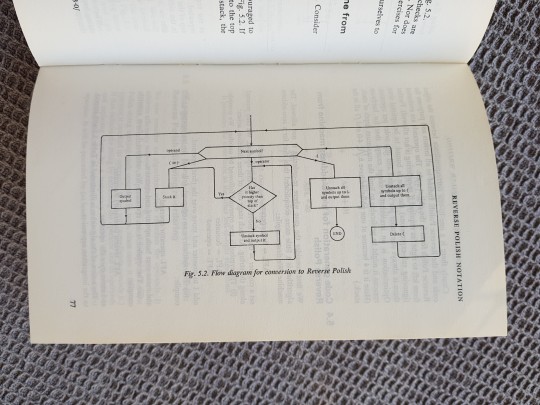
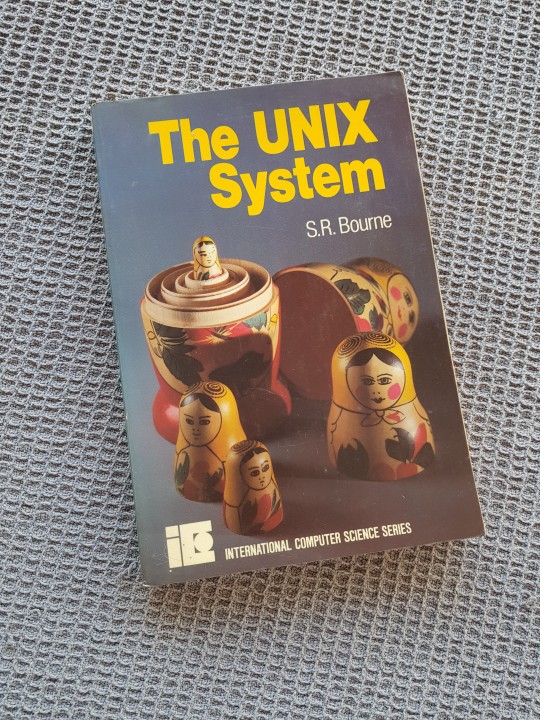





58 notes
·
View notes
Text
English Scans from Naruto Databook 3: Madara, Hashirama, Izuna, Tobirama, and Hiruzen
From the databook:
Hashirama Senju:
• Would like to fight: Uchiha Madara
Madara Uchiha:
• Would like to fight: The top echelon of Konoha

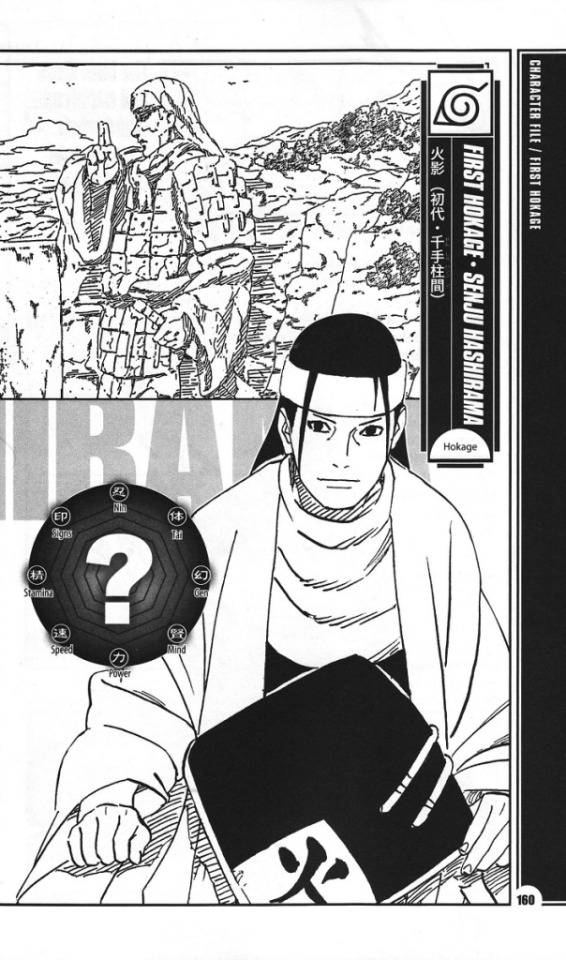

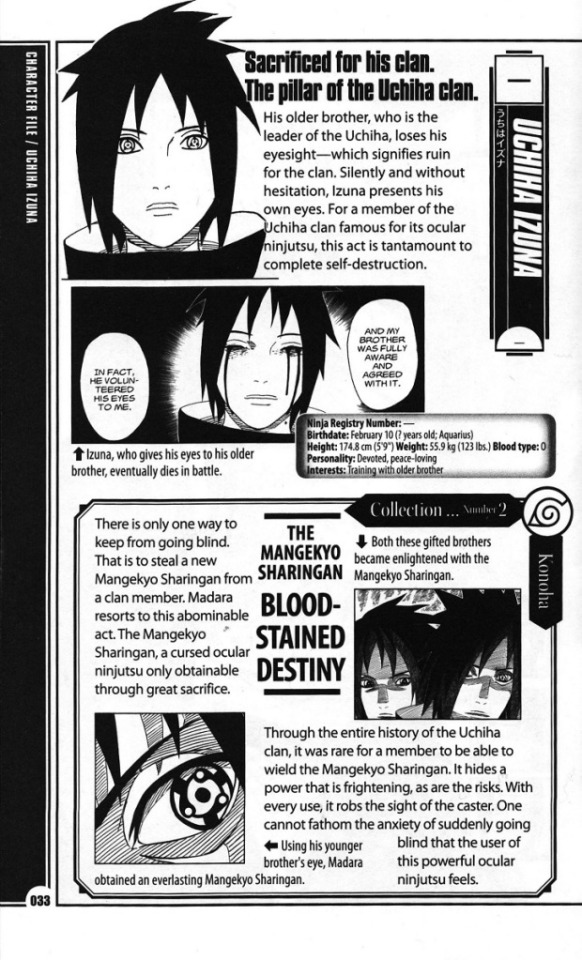
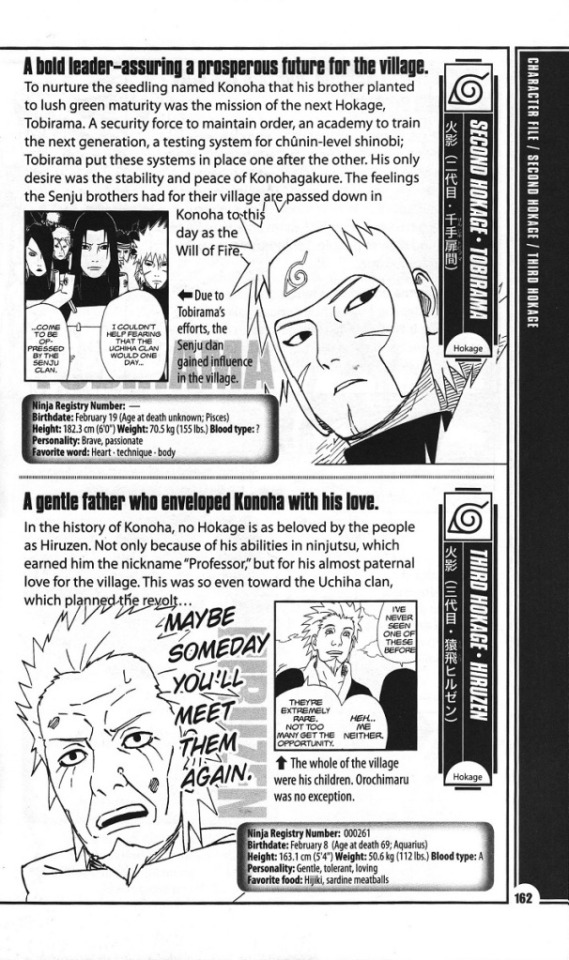
#i haven’t seen anyone talk about Madara most wanting to fight the upper echelon of Konoha!!
#says a lot about Madara, implies that Madara wasn’t trying to just kill all of Konoha back when he attacked the village, he wanted to fight the people in power
#sasuke reaching the same logical conclusion as madara had that those in power in Shinobi government were corrupt and needed to be dealt with
#Naruto databook 3#Naruto databook#Madara databook#hashirama databook#izuna databook#tobirama databook#hiruzen databook#naruto founders era#naruto critical#anti konoha#anti naruto ending#anti naruto fandom#pro sasuke#pro sasuke uchiha#pro madara#anti shinobi system#naruto meta#i haven’t seen anyone talk about Madara most wanting to fight the upper echelon of Konoha!!#says a lot about Madara implies that Madara wasn't trying to just kill all of Konoha back when he attacked the village#he wanted to fight the people in power#sasuke reaching the same logical conclusion as madara had#that those in shinobi government needed to be dealt with#hsmd#hashimada#naruto founders#Naruto warring states era#Madara uchiha#izuna uchiha
77 notes
·
View notes
Text
Theory on Fyodor's ability: Crime and Punishment
With the latest chapter, I can sort of imagine like 30 theories about what Fyodor's deal could be. Honestly, there are so many hints scattered way back from Untold Origins until now about the large-scale world-building of Bungou Stray dogs that we can imagine all sorts of possibilities for a person like Fyodor. I'll attempt to entertain one of them (this is not my only theory). In my opinion, it is clear he has a power that allows him to "endure" for long periods in one shape or another. That could be resurrection, reincarnation, regeneration, life force related power..- I guess the easiest way to describe it is an ability that helps him stick around. Right now Fyodor appears immortal, but I want to theorize on different aspects of what we know about him. These are key elements I want to focus on for my theory - they helped me narrow down certain options. I feel like the solution to the puzzle is figuring out how one ability can allow him to kill people and remain alive for long periods of time. 1. Fyodor's health, lifespan, and care for personal security: From what we've been able to gather, it seems Fyodor was alive in the 15th century, based on certain references from the latest chapter. However, there is an interesting aspect to his character: He cares very little for his physical safety - he gets intentionally captured all the time. We know this to be true from the time he got caught by PM, and there are theories he also ended up in Mersault partially because he wanted to be there. Within the latest chapter, he appears to have been captured by Bram's people on purpose once more. Furthermore, he tells Ace that he is prepared and "trained" to endure starvation.
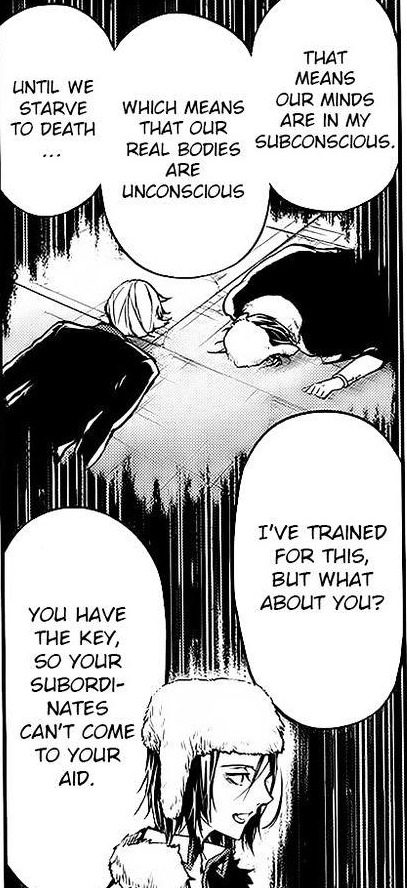
This isn't the only time he gets in harm's way - arguably the entirety of Dead Apple was him putting himself at risk. Even so, while he MAY be immortal, and he puts himself in danger of losing his life, he is very sensitive about his health. In one databook, he mentions that his number 1 weakness is specifically his weak, sickly constitution. It seems getting ill is so upsetting to him that even if he survives a difficult endeavor like getting drowned, it's something he "isn't able to afford". Fyodor mentions this when he tries to drown Sigma and Dazai. He is anemic and hates getting sick/needs to be very careful about his health, every cover is drawn to show his dark circles and pale skin, Fyodor even admires good complexions on other people because his isn't that great according to databooks. This is a huge part of his character, and whenever we see additional material about Fyodor, there is 50% chance it's about his health issues (even for DA side material, the joke was he can't do much on weekends because his doctor told him to be careful about his blood pressure, according to one bit). What could this tell us about him? Fyodor constantly complains about getting ill: if he can regenerate ultra fast, this typically wouldn't be a problem. He says getting sick would be "intolerable for him". Ultimately, in a logical setting, an immune system largely allows a person to "regenerate" and many sickly people have a reduced capacity of doing this. Fyodor being able to regenerate super fast doesn't make a ton of sense. It is perhaps possible that Fyodor can regenerate large chunks of damage, but then his body enters a state of "suspension" which is why he's sickly - however, this doesn't fully track with the rest of what his abilities can do. I believe the biggest issue with Crime and Punishment is figuring out how the same ability that can kill others also allows him to live a long life (assuming this is all one ability). To continue examining this aspect of Fyodor, the wounds on his hand from his tick of finger biting don't seem to regenerate any faster than regular?
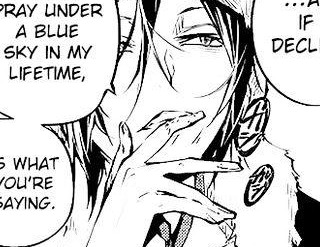
Harukawa is not overly consistent with any of this, just like most mangaka, and we don't see Fyodor biting his hands much later down the line, but there are a couple of times when it seems she's drawing him with wounds and scars on his arm.
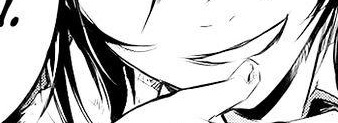
I can remember like 2-3 other panels that show a lot of mini-scars, but manga artists tend to not be consistent with this level of detail. Hands are hard to draw af.
2. Bleeding I am pretty sure Fyodor's ability has to do with blood. I always theorized that he murders people by sacrificing some of his own blood, leading him to be anemic - there is very specific bleeding imagery whenever he kills people, and they usually die from bleeding out. I thought that was his "punishment" for committing a crime.
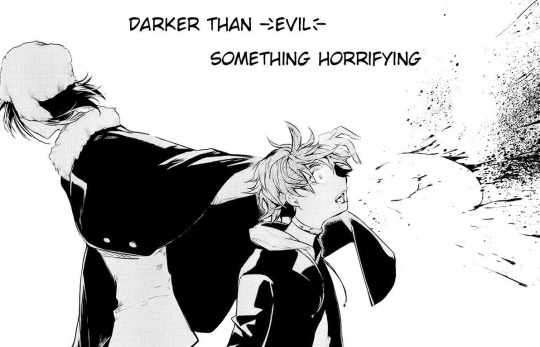
How would this work into immortality? In Christianity, life is heavily related to blood. You'll hear phrases like "Blood of the covenant", "blood of a lamb", and "sacrificial blood". Every person he kills "bleeds" out, yet he is anemic? Seems too random for it to be unrelated. So, what do we know? 1) He was alive in one way or shape in the 15th century, those are his memories, implying he, as a soul, has existed for over 600 years. He is long-lived. 2) Fyodor appears to be relatively unconcerned with dying, but appears to be worried about getting sick? 3) Fyodor himself says that being ill is his biggest weakness. It's canon he is anemic, and his health never gets better. 4) His scar from getting slashed by Bram healed since then, since there is no scar right now.
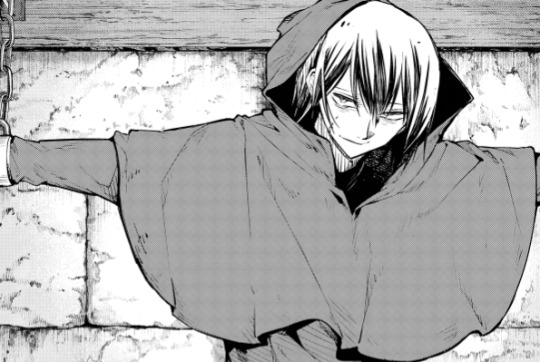
5) The wounds on his fingers don't heal super fast, meaning he likely doesn't have hyper regeneration. Being so sickly implies he doesn't have pure regeneration as well (from a logical point of view, but I suppose in a fictional setting it could make sense depending on how sensitive Asagiri is to detail). If he had regeneration, even to a baseline of his regular sickly self, he wouldn't say getting sick was "intolerable" for him, in my opinion. Fyodor isn't dramatic to complain about shit that doesn't get to him - he's alright with starvation and getting beaten. This sounds like he's afraid of more permanent damage (as an immune-compromised person, I can relate) If he got much sicker, he'd return to his old self eventually if he could regenerate, and he wouldn't have to worry that much. It is more likely he has something like complete resurrection from a state of being dead, rather than being able to regenerate over time. That follows what we already know. 6) His ability is connected to blood - making others bleed, and he himself being anemic. Blood in Christianity is associated with life. Does he have some form of life force manipulation? How does all of this come together? He is old af - meaning there is something up there. How could the above connect with immortality? A super sickly immortal? Why is he so sickly if he could regenerate? How would the same power that helps him live long also help him kill people?
I think it's possible that whatever he does with his abilities wears him out, and he has to change to another body eventually. Possibilities: 1) Killing people makes him sacrifice blood, so he gets sicker, until he dies. 2) Whenever he dies, it takes him a while to come back, so he can't afford to get sick and miss out on plans. However, if he has to die, it's still not a big deal if the reward is worth it, especially since he can come back, and others cannot. 3) Purely dying and reviving is easier than just switching to another body from sickly decay. The guy seems to panic more about getting sick than getting killed. Meaning he possibly has "periods" between resurrection/reincarnation/reviving. Perhaps he needs to die to revive into full health.
I guess it's possible that Fyodor's ability is related to life force itself? But how does that relate to the Crime and Punishment aspect?
Right now, I'd like to theorize that Fyodor's ability is essentially to "possess" people like a demon. Stay with me here. I'll try to explain what I mean by this: Fyodor can "possess" bodies. If he possesses them the right way, he takes over them and "rewrites them" to become him, including the physical appearance, which is why he looks the same throughout centuries. If he possesses them "wrongly", they die. The "crime/sin" is taking the body of another person - this is a profound violation in many religious teachings. "Possession" is a sin. Being able to possess bodies is one of the main trademarks of a Demon, which is how Fyodor is always nicknamed. Before he dies, he can change bodies.
I guess the easiest theory for me to imagine is that Fyodor is just a consciousness at this point, and he needs to "possess" bodies to keep living. Every single body he possesses occasionally wears down (this is the "punishment" part of his power), and he needs to keep finding new ones to keep living. Killing people wears down his current body even faster. Every time Fyodor "possesses" a new person he completely returns to his "baseline" form, and that is why he has no "old" scars from the 15th century. I assume finding a good body to possess may be more difficult, so that is why he avoids wearing down the current body with his power. Perhaps he starts killing his current host to possess another? And that is why he starts losing blood, making him anemic. The trick is that he doesn't finish the process. The reason Sigma was "brought into the world" was for Fyodor to have another "clean" body to possess. Asagiri even mentioned that Sigma was created in relation to specifically Fyodor's color pattern. Additionally, Asagiri told us to pay attention to "Chekhov's gun" cliffhangers, and this is one of the elements of the story we never got a resolution for - why was Sigma brought into this world, and why was he specifically made in relation to Fyodor's character? Having a body created by the Book, as a clean slate, may be perfect for Fyodor. Perhaps he cannot fully recover anymore from his broken health, even when he "reforms" after possessing someone, and that is why getting sick is worse for him than death - every time he "possesses someone" and takes their body, his body recovers less and less. Now, I want to elaborate on this. Why did Crime and Punishment not attack Fyodor in the mist? I guess one possibility is that Fyodor is a sentient ability. An ability that keeps possessing people.
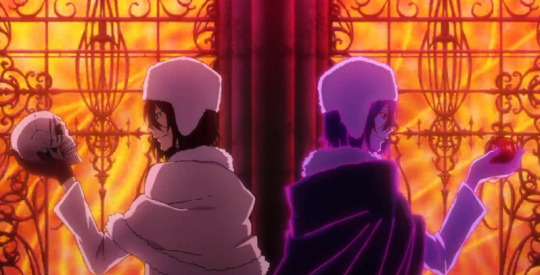
Fyodor's ability won't attack him, because it is the consciousness controlling the body. "Crime and Punishment are close acquaintances, the borders between us vanish"
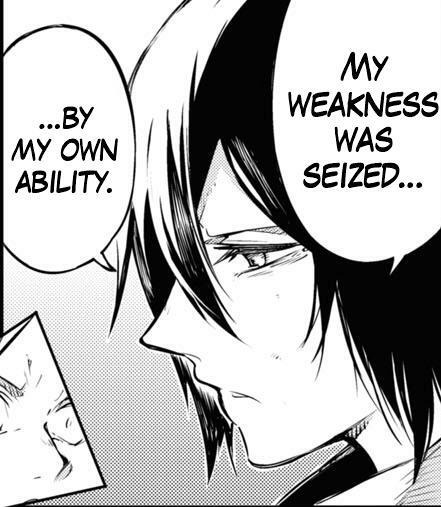
His fake speech to Sigma might be based on "half-truths" I have a theory that Fyodor's power ultimately synthesized with his real personality and became one indistinguishable whole. "The borders between us vanish" could possibly be a reference of the border between him and his power disappearing and leaving him corrupted. In my opinion, this would also explain why Fyodor wants to get rid of abilities - he wants to remove this curse from himself. While the ability may have conjoined with the real Fyodor, it still may be lost in how to act, and the real him continues being the root of all his desires. Dostoevsky's character was based on a chapter from Brother Karamazov where Vanya talks with the Devil - I feel like this is a huge hint to his character and the possible "possessive" part of his ability. Did human Fyodor summon a devil and had it become his power? Are abilities demons? Honestly, there are so many ways to interpret what we're seeing in BSD at the moment. I find it interesting that Fyodor wanted to see Bram and his "evil"
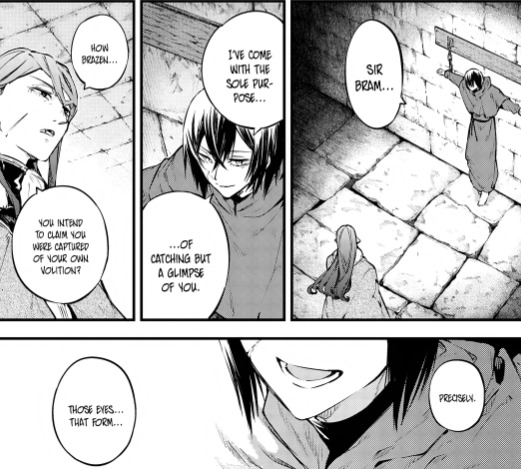
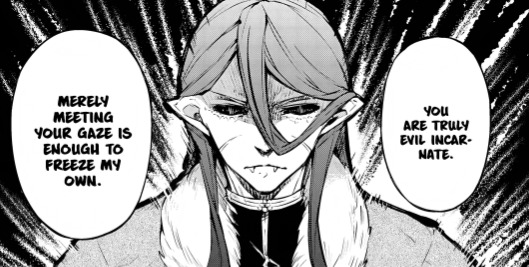
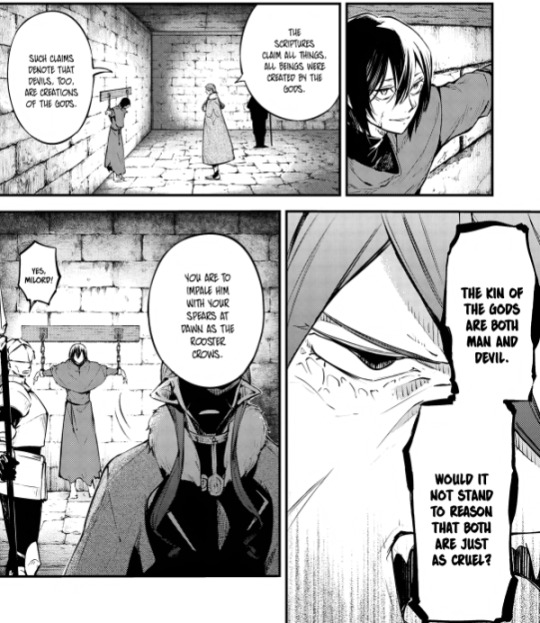
I think Fyodor may be fascinated with the existence of "good" and "evil" as equals - and is possibly fascinated by why "someone like him" exists. Why would God create an ultimately "evil" ability? And what about others who were born with evil powers such as Bram? They are just like Fyodor, which is why he relates to him. I feel like there is a lot of discussion to be had about the possible origins of abilities - the religious imagery, decay of angel themes, Nephilim theories, but I will leave this for another post. Also, I could write pages about Fyodor's ability, backstory and how it may be influencing his world view. I sort of have two theories in my head: Fyodor is a demon, or Fyodor is a human who was influenced by his "demonic" ability. I wrote this in a rush, so it's not well thought out at all, just a bunch of rambling, so thanks for reading again <333
41 notes
·
View notes
Note
I actually find it confusing that Kishimoto wanted to portray Naruto as an idiot to the readers but at the same time someone creative and empathetic. Like, to have the amount of empathy that Naruto has, you need to have a very high emotional intelligence and he is also quite creative, something that I don't think the idiot would be.
Context 1 | Context 2 | Context 3
Different types of intelligence! Being "emotionally smart" doesn't necessarily mean being "logic smart" and vice versa. Take former "gifted kids" who have a high IQ but struggle severely in any social setting due to a low EQ. Or remember the kids from your own class who excelled at art or creative writing but couldn't do Maths to save their lives.
Still, Naruto scores pretty low in the first two Databooks when it comes to intelligence, so I have to assume that Kishimoto's definition of intelligence is IQ over EQ.

And it's not exactly an unpopular definition of intelligence either. Dictionaries will usually define "intelligence" in a way that relates to acquiring and applying information and letting it guide your actions. "Intelligence" is rarely defined in a way that also incorporates emotional intelligence.





But Naruto is more about feeling than thinking and more about instinct than analysis. Hence, Naruto is slow to grasp new concepts and will usually act before thinking, resulting in a bad performance and foolish behavior. This is why most characters and audience members would consider Naruto a lovable idiot.
As a side note: If you'd like to continue this conversation, I'd prefer moving it to @not-littering-my-main :)
17 notes
·
View notes
Text
I was in Twitter, which doesn’t happen really often, and I saw this:
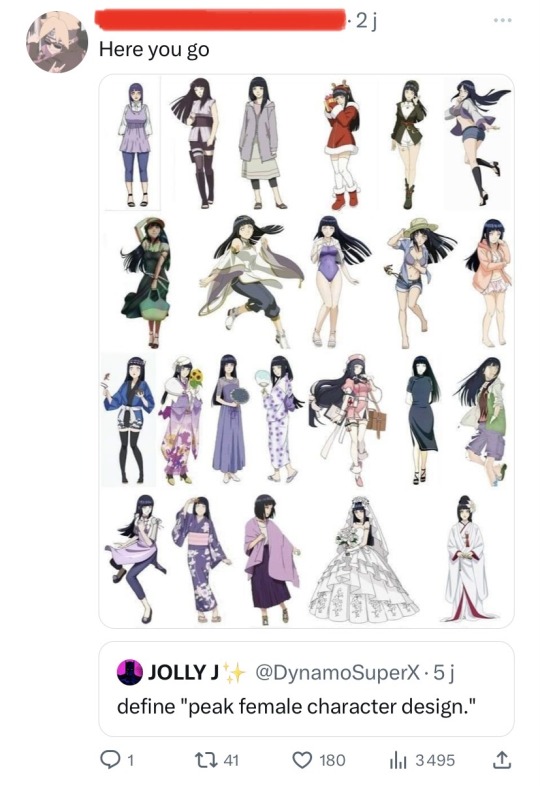
At first I thought "Well, half of the replies to the tweets seem to think that a good female character designs is an over-sexualized one, so it’s not surprising that people think Hinata has a good design…"
But then I realized that the problem of Hinata’s design wasn’t just the fact that she was over-sexualized in the anime and official arts. The problem of her design is that it’s BLAND.
Let’s take a look at her Genin design first:
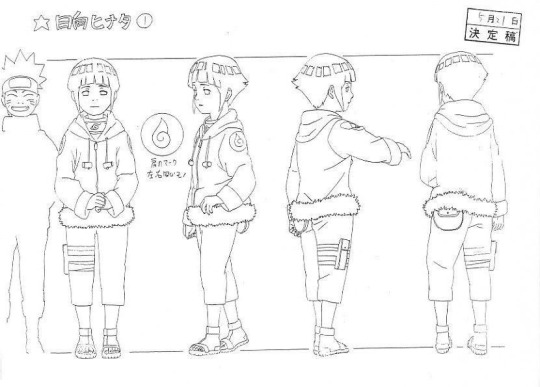
To be honest, her Genin design is okay. The pompons on her jacket accentuated her soft and childish side, it’s a nice touch to her outfit. Her hair looks good and it’s pretty original to not gave her a more "girly" hairstyle.
But SP decided to gave her a more conventionally attractive and feminine face, and to sexualize her even though she’s 12.


After the time’s skip…
Her design isn’t extraordinary. Hinata’s outfit doesn’t have pompons on her jacket anymore, which seems logical since she grew up. But her outfit is now pretty bland, it just looks like a regular sport outfit. Her haircut is really classical and doesn’t have anything special to it except the two bangs that shape Hinata’s face.
Nothing interesting to say except that Hinata’s design is generic and kinda boring.
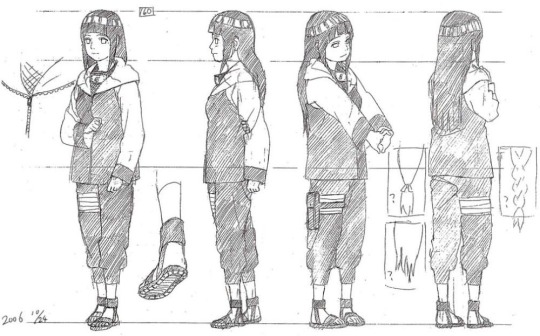
The Last design:
With time, Hinata’s design just get more and more generic. Her round face was changed for a pointy chin, and she even completely lose her bangs in her design for The Last. We can’t really tell if she’s a ninja or not, since she doesn’t have her hitai-ate anymore, and that her outfit doesn’t look very… practical for fighting.
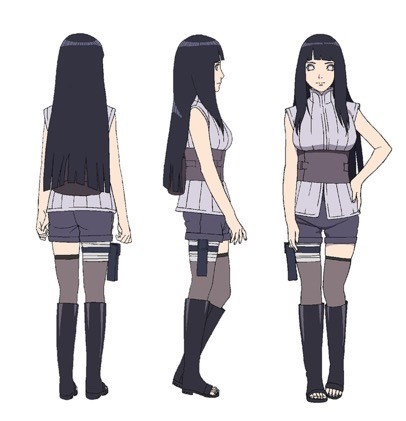
The worst part about her design is that it’s OOC. A comment that Kishi made in the first Databook makes us know that Hinata isn’t interested in fashion, and that she was apparently not the type to wear clothes that reveal her skin.

(Kishi even tells us that she looks bland)
But making Hinata’s clothes shorter to make her more appealing to the audience is more important than the coherence of the story I guess… The black socks she wears are similar to the ones that girls in hentai wear, but in the design Kishimoto had previously drawn of Hinata, we can see Hinata was wearing the usual fishnet socks that shinobi wear (and she still has the shape of her bangs)
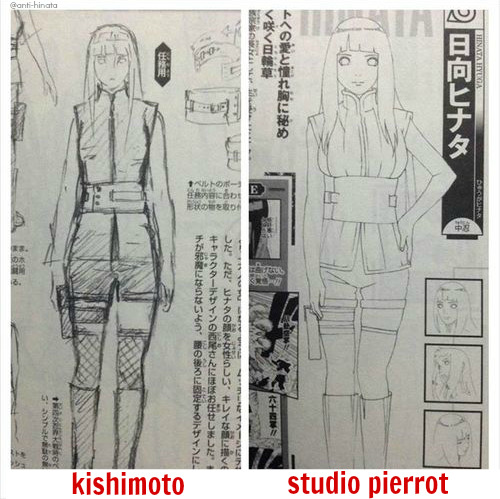
At first I thought that SP decided to replace the fishnet socks by the black socks because it was easier to animate, or just because they wanted to change of art style to distance themselves from the original anime. But then I noticed that Tenten was wearing fishnet socks on her The Last design… So there’s not other explanation for this change except the fact that it makes Hinata looks even more hentai-related. Great.
And finally, the Boruto Design:
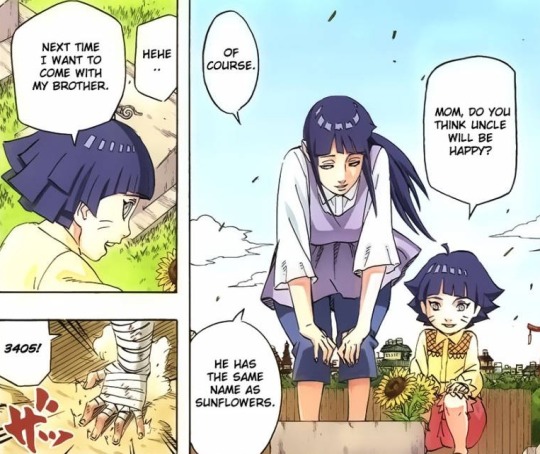
Hinata’s design in chapter 700th was… decent. Her outfit look like an "adult" outfit, and I think her tied up hair looks pretty good. Her design is still bland and forgettable, but it’s fine. But for some reasons, her design was changed for the Boruto movie:
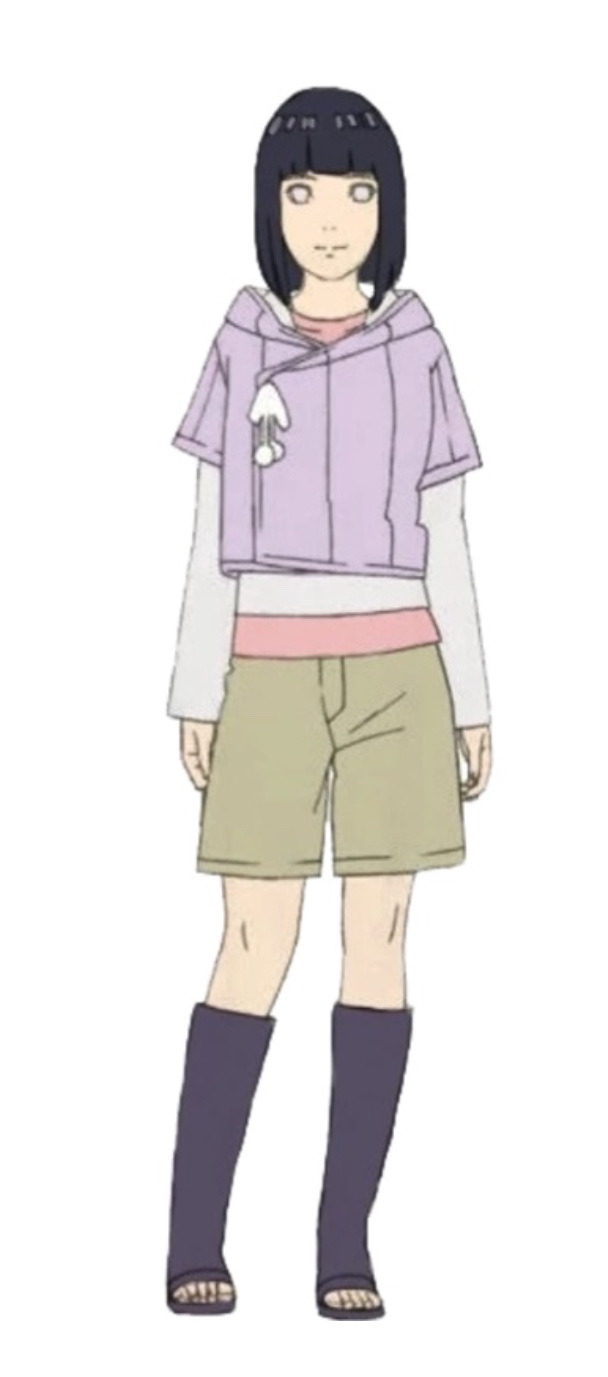
Kishimoto designed it, so there must be a reason for the changes. So, Hinata now has shorter hair and shorter clothes. And frankly, it looks like she’s wearing the clothes she wore when she was a genin, even the pompons are back. Not only does the color palet makes it hard to look at Hinata without laughing, the shape of the outfits is also pretty weird.
I don’t know if Kishi redesigned Hinata to make her more childish in order to show us that her wedding with Naruto only accentuate the fact that she’s still a little girl in love, but if it’s the case… well played I guess??
#naruto#anti hinata#anti hinata fandom#antihinata#kishimoto#anti the last#anti boruto next generation#my post
119 notes
·
View notes
Text
SasuKarin PlayList 🎶
And some retrospective of my ordered commissions and some edits, maybe
PREVIOUS << 2 / 10 >> NEXT
Basically, just to promote a little more my playlist, I will explain the reasons for choosing those expecific songs.
Link here >>> [ X ]
I will post every day at this same time 21:00, Brazil time.
This analysis, and the songs, are how I see their dynamic, both, in the canon manga (with the databooks) and in an AU where the writing would be favorable for the endgame, a narrative that all of us as SasuKarin stans agree with.
LET'S GOOOOOOOOOOOOOOOOOOOOOOOOOO✨
5) Like you do by Joji
This was the first song I heard that SasuKarin came up in my mind, in the refrain all I could see was SK's painels.
Lost in the blue
They don't love me like you do


Those chills that I knew
They were nothing without you


And everyone else
They don't matter now


You're the one I can't lose
No one loves me like you do


And the first edit I ever made, the one which would be the turning point for me to create this account. >> [ X ]
Give some love to it. I poured my heart in this video 🥹
6) Hard to do by Gavin James
I choose this song based in the affirmative that love is a hard thing to do, that's something complex. Starting from the name of the song.
The first verses talk about someone who has lost the sense of home, that the place where she (Karin) lives doesn't have that feeling of home (otokagure), but with the presence of that someone (Sasuke) makes everything easier. But at the same time we can interpret that at the moment when Sasuke is immersed in darkness, Karin feels confused and lost, because she feels at home only by his side.
The song talks about a clash between logic and emotion regarding vulnerability and uncertainty when loving someone. The song also says about distance, in the communication and emotional distance, so all the trauma events that have happen affected the way they expressed themselves and reacted to reality.

dan.mag in Instagram
I choose this verses for this commission because I thought about an cenario where Sasuke would be away for a while, perhaps on a dangerous mission, one of those to locate Kaguya, and upon returning Karin feels this urge to hug him. I know she's not like that, But as time passes, she begins to process her feelings and be more open about them.
And here the art focuses on Sasuke's expressions, he is also learning about his own emotions.
7) Standing next to you by JungKook
There aren't many reasons why I chose this song, it's more for this specific part.

Archiri Usagi on Instagram
I see SasuKarin as a resilient fandom, it exists regardless of what people say or do. Not even time has erased them and no one can deny that there is coherence in shipping them. Isn't a crackship.
There's a part of the song that's said "More deep than DNA" this highlights a connection between the lovers is fundamental and inherent to their existence, something that cannot be removed or destroyed and I like that because at the moment Kishi created Karin and the rest of Taka he was thinking about Sasuke, they have similarities and are equal to one another.
I will leave here the analyses that I have already done showing that the Taka team represents parts of Sasuke, their similarities and developments.
X
X
X
X
X
X
X
That's it.
#Spotify#naruto#naruto shippuden#anti naruto ending#karin uzumaki#naruto manga#fandom: naruto#naruto series#naruto anime#naruto analysis#naruto art#naruto au#naruto fandom#naruto headcanons#sasuke uchiha#me: sasukarin#sasukarinmonth#pro sasukarin#sasukarin fanart#sasukarin fanfic#sasukarin#meta: sk#! sk moment#sk fandom#skfamily#sasuke x karin#sasuke and karin#サス香#my post
5 notes
·
View notes
Note
Hi, do you know if the manga shows kakashi being stated to have graduated the academy at age 5? because someone said that they only said it in databooks and that you have to trust only the official source material
I mean, officially we have no manga instance where his acadamy graduation age is stated, but in the chunin exam arc he stares ro Iruka ‘i was half Naruto’s age when i became a chunin’
Naruto at this point is 12. Kakashi at half Naruto’s age would be six.
So it’s stated pretty clearly that Kakashi was a chunin at six years old.
There’s only two logical courses to take from there
Go with the data book and believe he graduated the acadamy at five and became a chunin a year later
Or somehow believe he became a chunin in under a year
Either way he’s still the youngest genin and chunin in canon
7 notes
·
View notes
Note
Personally when it comes to Hawks I really refrain myself from having any expectation. Not because I hate him or anything but because he's a damn wild card and I can never predict him. When it comes to Hawks Hori subverts my every expectation so I am just baffled at this character at this point. Villain Hawks, Dabihawks childhood friend, HPSC assassin (debunked by databook about Madam President didn't like previous President's murdery method). Like, how many times Hawks was teased to have confrontation? Bakugou, Tomura, Dabi, Toga, but he got AFO instead. The thing is, that makes sense. AFO IS Hawks' assignment. He will prioritize his duty over personal conflict. If we try to think based on pure logic (like him usually), we all know that there's no way he can stop Toga's parade with his strength, but he can be a meat shield to stop AFO or making him monologue (he's an expert for that) so him facing AFO with at best damaged quirk to be stolen is the most cost-effective move. So I personally think no one knows who Hawks truly is even now except Horikoshi. Some hate him, some love him, some thinks he's right, some thinks he's wrong, his place right now is just so... ambiguous. Sigh, I'll just wait Hori patiently to deliver the true Keigo and see whether I'll like him or not.

#I mean same#I agree with everything here#I’m not making specific predictions#I have absolutely no idea what to predict#anonymous#bnha asks
11 notes
·
View notes
Note
Do the Uchiha really have the only “powerful chakra”? I have some doubts...Hi! I'm the same person who asked about the pro-Uchiha blogs earlier (yes, I’m still thinking about all of this 😅), and now I’ve come across another question after reading a few more fandom debates.
In several spaces, I’ve seen people claim that the Uchiha Clan is the only one in the entire series with large, distinctly “powerful” chakra reserves.According to those arguments, neither the Senju nor the Uzumaki actually have strong or large chakra, and that idea is supposedly just fanon, created by the fandom to make those clans seem more important than they really are.Some also say that the red hair of the Uzumaki doesn’t symbolize power, but is simply a “peculiar trait.”They argue that the Senju and Uzumaki, as Asura’s descendants, didn’t inherit anything particularly special in terms of chakra.
On top of that, it’s claimed that the Uchiha have a pure bloodline, which is supposedly why their descendants naturally possess more “voluminous and powerful” chakra compared to other clans.Most of this is backed by information from the Databooks, but personally, I feel that the only true canon comes from what Kishimoto shows in the manga or confirms directly in interviews.
Everything else Databooks, novels, guidebooks I treat as supplemental material, not definitive.Honestly, I feel like these kinds of arguments come more from competitive fandom culture than from anything Kishimoto actually intended.We know from the manga that the Uzumaki are described as having “incredibly long lifespans” and “massive chakra reserves”, so much so that they were specifically sought after as jinchūriki because they were among the only people capable of containing the Tailed Beasts.That alone speaks to their resilience and chakra strength.We also know that the Senju Clan was the only group capable of rivaling the Uchiha, and that Hashirama’s chakra was so immense, even Madara acknowledged it as monstrous. So clearly, that lineage carried something extraordinary as well.
Calling all of that “just fanon” simply because it doesn’t appear in a Databook feels like a forced attempt to downplay the power and legacy of other clans.And to be honest, the whole “pure bloodline” argument sounds more like fandom supremacy logic than something Kishimoto ever seriously established in the narrative.So, my take is: what the manga shows holds more weight than what a Databook edits in after the fact.And there’s more than enough canonical evidence to say that both the Senju and the Uzumaki had incredibly powerful, unique chakra even if it’s different from the Uchiha’s.
Hi again anon!
They're not wrong. But they're not right either.
The Uzumaki and Senju clans aren't specifically described as having 'large powerful chakra reserves.' Instead, they are noted for their stamina and physical energy. According to Ebisu, stamina is necessary to produce chakra, so in theory, they should have a reasonable amount of chakra reserves.

Kushina explains why she was chosen to be the host of Kurama.
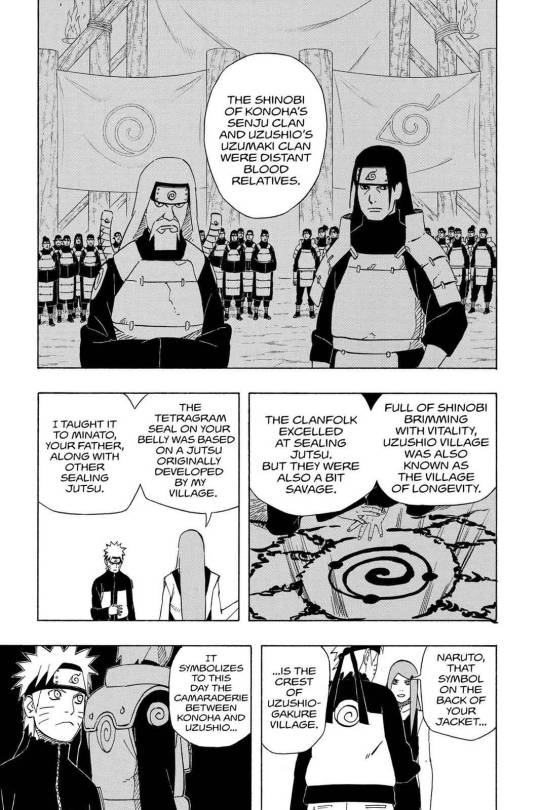
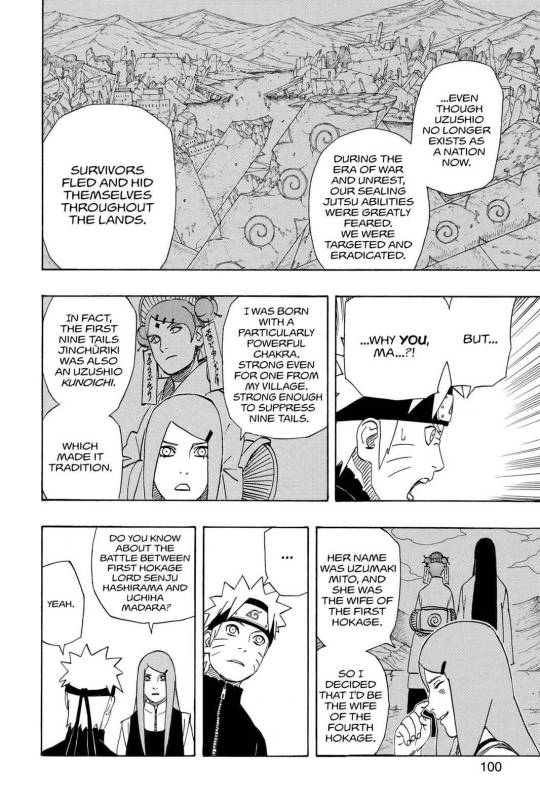
The Uzumaki clan, in particular, is known for their vitality and excels at sealing jutsu. I like to think of it as a specialty, similar to the Nara clan's control of shadows. Kushina (and Mito, apparently) was born with 'a particularly powerful chakra, strong even for one from my village, strong enough to suppress the Nine-Tails'. My theory is that her 'particularly powerful chakra' enables her to create the chakra chains she uses to tame Kurama. This is a bit similar to the Mangekyō Sharingan, in the sense that not everyone from the Uzumaki clan could obtain such abilities.
From those words, it seems that the Uzumaki have stronger chakra compared to other clans, but Kushina's chakra is definitely stronger than that of the other members of her clan. I also believe that Karin must have similar potential to Kushina.
Plus, Nagato likely possesses a significant amount of chakra to effectively wield the Rinnegan for years. While he may not be on the same level as Madara or Sasuke, his abilities are still impressive.
Just to add, the red hair isn't merely a 'peculiar trait'; it symbolizes their vitality. You can see this clearly in Nagato, for example :
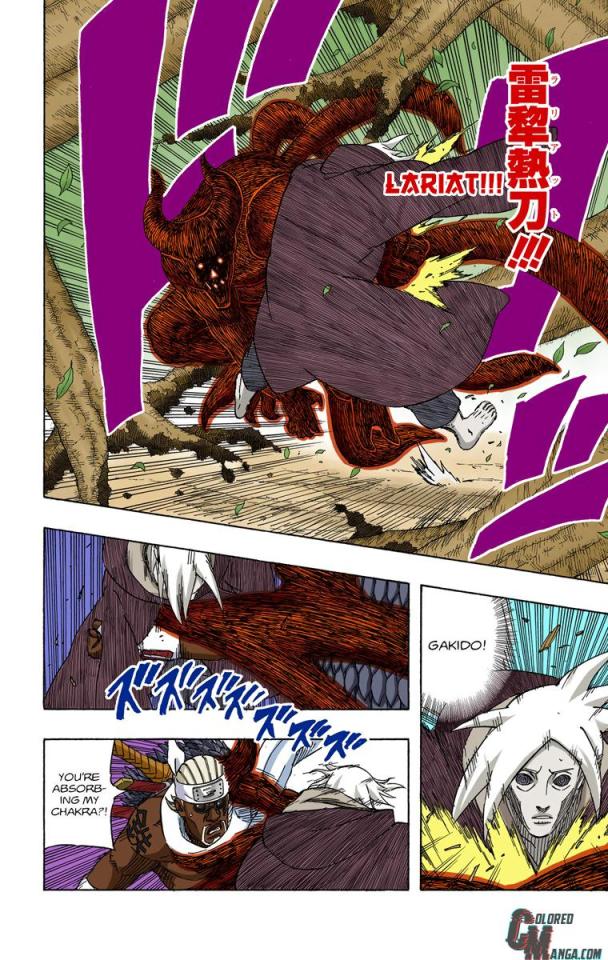
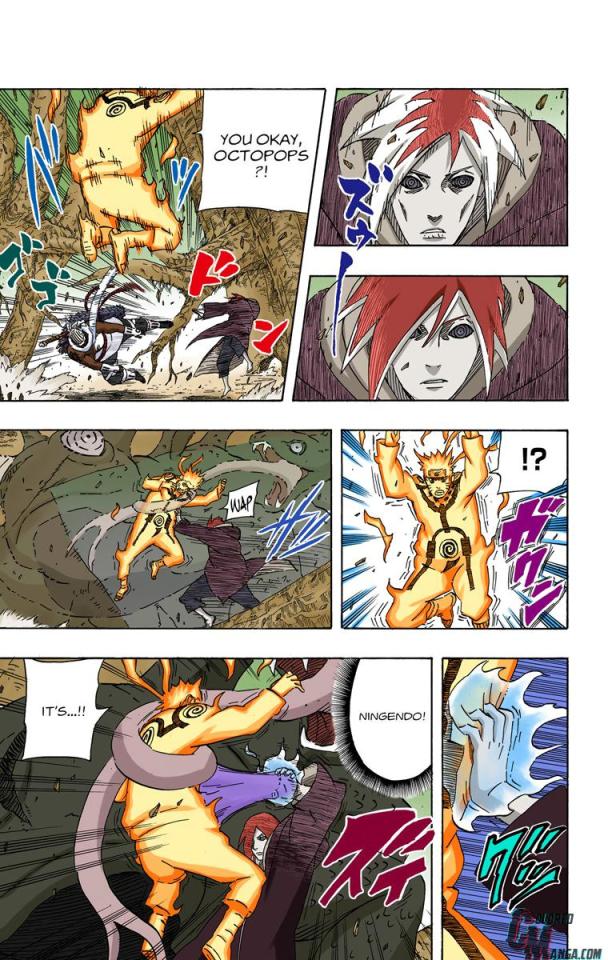
From the Minato one shot, there's also that panel.
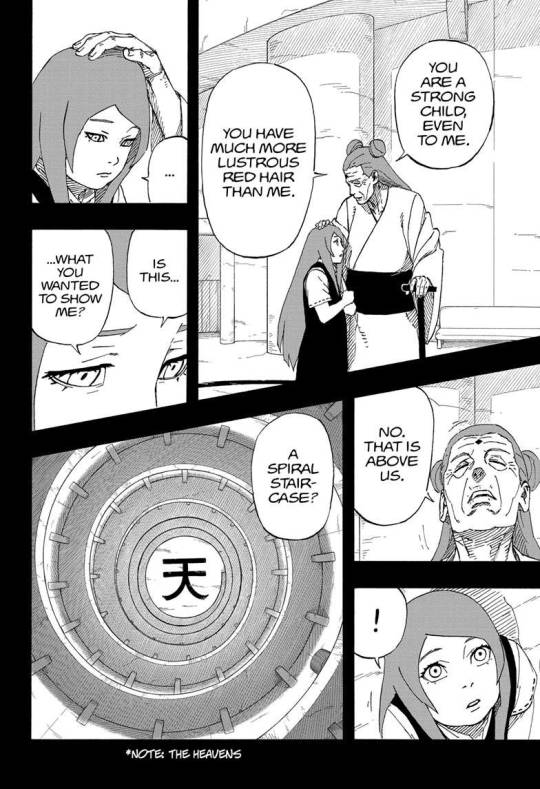
Mito connects strength to their hair color. I think it's safe to say their red hair is a sign of their vitality & strength.
0 notes
Note
I only trust you to tell me this. Does Dazai have any type he prefers physically??
From my memory, about 3-4 entries (databooks, interviews, magazines..) insist he doesn't have a type. I always say how funny it is that this is that one part that never changes, regardless of whether he's serious or joking. Guidebooks insist he loves beautiful women, but Kunikida always says the guy chases after any half-pretty lady, so perhaps it's questionable how low or high his standards truly are. That one interview said he's confident he can shape **any** woman to suit his tastes - and if that's true, I can't imagine whatever he wants to be too niche or specific if "any" woman can become it. Personally, I think Dazai sees "women" as just another hobby, a pleasant thing to waste his time on like booze or whatever. The dude doesn't approach this topic all that seriously - so, logically, any type of woman can be fun because she's something new to "explore". But for the joke of it, let me try and remember the women Dazai has expressed attraction for/approached (keep in mind that most no-name side characters are drawn to look very similarly). Higuchi (blonde, short, around his age) Sasaki (brunette, tall, around his age/older) Manga and LN waitress (brunette, stocky, much older) Anime waitress (brunette, his age?) Nurse (dark haired, older?) Murder victim Yamagiwa (brunette/dirty blonde, around his age or older since she was a regular and relatively experienced police officer, and I think you can't become one in Japan before 20, so yeah). Random lady that was walking that dog (brunette, same age?) A bunch of random women from wan/the anthology (purely from memory): -one was blonde, younger -one was a blonde waitress, she had no distinct features -two random older, brunette ladies He most frequently flirted with the waitress (anime and manga) and Higuchi (said she was pretty 3-4 different times). None of these women have anything in common, so it's safe to say he might just like anyone pretty enough. It's, of course, debatable who he's flirting with because he's really interested, and who's a target to use, but imo - he just doesn't have high standards for basic physical appeal. The waitress he flirts with, in the manga and LN, is based on the lady from No Longer Human - an older, married lady he tried to kill himself with, but fails. The main character of NLH, Yozo, says that was the only person he ever truly loved IIRC. That's why some people connect Dazai with "older" women, but was that just a coincidence or an actual preference of his? Who knows. I think it just happened that she was older, what's sure is that he's "open-minded"
29 notes
·
View notes
Note
OK this is utterly random but I was digging for references to draw Dita and something about him looks. Off? I don't have the databook so my only references here are the CoM profile image and the in-game sprite in Interlude but then I realized that his eye color is significantly darker than Fragments we're currently aware of?? Even Eigha's are more Fragment red than Dita's. I think I'm losing my mind. Surely he wouldn't wear different contact lenses?
I don't really have a goal here I just don't have anyone else to bother with my brainrot and you're chill so presumably up for someone else's brainrot. Cool if not tho
i got pretty curious, so i decided to see for myself. just to note, theodore has pure #FF0000 red eyes so i didn't include him, none of the others have anything like that. the databook makes sure to make a distinction when talking about hatsutori's eyes too (i.e. saying they're not pure red, that they're dark red. i assume the same applies to the rest too).
if you're curious, there is not really much on ditasword in the databook, there's a paragraph about it on shinano's entry that teases CoM's premise and the nature of the show, what it is, mentions miwa and gives a little information about him etc. i feel like the only thing that isn't mentioned in the interlude or other material is that eigha as a character appears in season 2 and 4 (so he isn't in season 1 or 3). there's a drawing in the databook that can be seen in thumbnail form in miwa's room. i think it's the poster with taka on it. it's a little hard to see tho. the poster with shiyo on it is based on the art on the CoM website with ryuu replaced with eigha. as far as i know there's no HD version of the half with eigha on it.
here is what i ended up with:
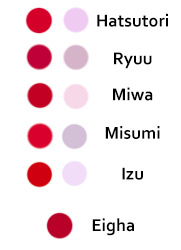
it's something like this. (sorry the pic isn't aligned neatly)
i compared in-game sprites. any inconsistency in other pictures, i think i personally rule out as just that, inconsistencies.
looking purely by value, ryuu's eyes are the darkest among the fragments, miwa in second, then izu, hatsutori, misumi. i included hair color too for some reason. i was most surprised that misumi has the lightest eyes. izu is weird because his eyes are more RED than anyone else. overall, there doesn't seem to be any pattern or correlation for why they're all different. my guess is that it's just a design thing. we say "pink" hair, but it's noted to be shades of magenta. so by the logic of design choice, it makes sense that miwa, who is a 60+ year old man who pretends to be 40 years younger and plays an anime boy for a living, has the pinkest hair (since it's cute). ryuu having a sort of muddy, ashy purple. hatsutori having probably the least blemished magenta since he's got an otherworldly cult leader sort of mood going on, etc.
my personal outlook on color variation for a while has been that not unlike a gemstone, there are different degrees of purity and such, and if you consider theodore the "purest", then the other fragments appearance suddenly start to make sense. something like this:
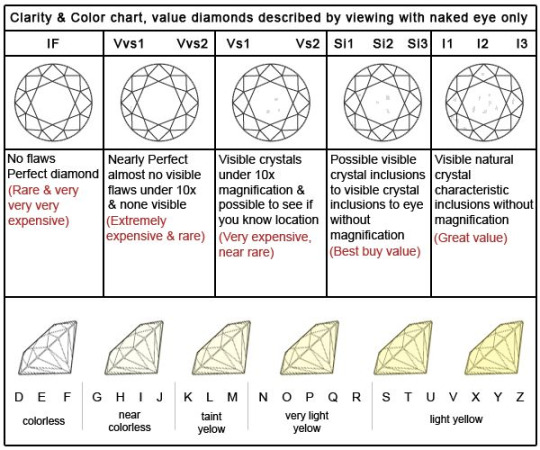
tho, idk if this has any basis in reality. it's just a funny thing i thought of... (yknow since fragments, rocks... etc)
as for eigha... his eyes are darker than ryuu's. i feel like that's consistent with someone wearing contacts over normal dark eyes. i do think this is a factor, because the contacts in miwa's bathroom are noted to be black, not brown. i think red would definitely look weird under brown contacts, since yknow that kind of thing does peek out a bit. someone would have clocked the deception pretty fast if they compared dita in the show and miwa out and about. of course it's a lot of show don't tell. you just find miwa's disguise in his bathroom. it's obvious the implication is "dita's look is what miwa actually looks like" but the vigilant might still consider other avenues. i'm lazy so i just go with the most obvious and probably intended implication. this is just an aside, but i honestly would have snapped, the fragments have lightly colored eyelashes and eyebrows, so on work days miwa would have to tint them to look darker going to the studio or whatever else, wipe it all off and get in dita costume, then put it back on to go back home, then go home and wipe it off again...
we don't know what either person who plays eigha looks like, but since it's the inverse situation... i guess it makes sense. (if shiyo really is actually a real harada, it'd be auburn dark red under there?!?!!?!! <-instant otaku death) he does have a sprite where his eyes are glowing, but since it's a 2.5D show i don't rule out special effects, post processing, etc.
since the game collaboration is based on the movie, i'm fully assuming it's shiyo, but there's really nothing saying it can't be taka...?? i have no idea!!! i think it's definitely shiyo though!!!
overall, i didn't observe anything abnormal about miwa compared to the other fragments, but i also have no idea why izu's eye color is so drastically different from misumi's. i expected them to be the same since it's misumi's fragment after all.
#anonymous#ask#im not sure what this does for you but i had a good think about it#thanks for the interesting ask youre always welcome to come to me for anything else <3
0 notes
Text
Transistor-Transistor Logic (TTL) Market | ADM, Chembio Diagnostics, GoldStar, Harris Corporation
Introduction:
The introduction to the report serves as a gateway into the comprehensive world of the transistor-transistor logic (ttl) market. As industries continue to evolve and adapt to changing consumer demands and technological advancements, understanding the market dynamics becomes paramount for industry stakeholders. The report takes on the responsibility of offering a profound and all-encompassing analysis of the transistor-transistor logic (ttl) market, catering to the needs of a diverse audience that includes manufacturers, suppliers, distributors, and investors.
Scope and Purpose:
The report's primary goal is to provide invaluable insights that empower industry stakeholders to make informed decisions. Whether it's manufacturers seeking to refine their product offerings, suppliers strategizing their supply chain management, distributors gauging market trends, or investors evaluating potential opportunities, the report aims to be a comprehensive guide. It endeavors to illuminate the current status of the transistor-transistor logic (ttl) market while projecting its future trends.
Request for Sample Report:
Value to Industry Stakeholders:
Recognizing that knowledge is power, the report promises to deliver a wealth of information encompassing various aspects of the transistor-transistor logic (ttl) market. By delving into the intricacies of market dynamics, competition, growth avenues, challenges, and regional variations, the report seeks to equip its readers with an arsenal of insights. This information is not merely descriptive; rather, it's intended to be actionable, aiding stakeholders in making critical decisions that can shape their strategies and endeavors in the market.
Promising Comprehensive Analysis:
To fulfill its promises, the report assures a comprehensive analysis that leaves no stone unturned. It pledges to unravel the factors propelling the market's growth, dissecting shifts in consumer preferences and technological breakthroughs that are driving the demand for transistor-transistor logic (ttl) products. Simultaneously, it acknowledges that challenges and obstacles are part of any industry landscape, and it vows to illuminate these hurdles, be it economic uncertainties or the intense competition that often characterizes such markets.
Guiding the Path Forward:
As the report extends an invitation to its readers to explore its contents, it sets the stage for uncovering the competitive landscape. It introduces the major players in the transistor-transistor logic (ttl) market and their strategies, offering insights into what makes them thrive. This insight-rich analysis is meant to guide others on their path forward – whether it's to navigate the competition more effectively or to find inspiration in successful strategies.
Anticipation of Insights:
With an awareness that the market is not monolithic but rather a composition of various segments, the report pledges to provide a nuanced understanding of these segments. It promises to detail their sizes, potential growth trajectories, and key trends. This targeted knowledge assists stakeholders in carving out specialized strategies and ensuring optimal resource allocation.
Market Dynamics:
Factors Driving Market Growth: The section dedicated to the factors driving the growth of the transistor-transistor logic (ttl) market provides a comprehensive overview of the key forces propelling its expansion. It delves into a multi-dimensional analysis that underscores the multifaceted nature of this growth. The following aspects are discussed in detail:
Changing Consumer Preferences: The report recognizes that consumer preferences are ever-evolving, influenced by shifting lifestyles, demographics, and societal trends. It highlights how transistor-transistor logic (ttl) products are witnessing increasing demand due to consumers' heightened awareness of environmental sustainability and their preference for more efficient and eco-friendly solutions. As consumers increasingly seek products that align with their values, the market experiences a surge in demand.
Technological Advancements: A prominent driver of market growth is technological progress. The report emphasizes how advancements in manufacturing processes, materials, and product designs are enhancing the appeal and performance of transistor-transistor logic (ttl) products. These innovations lead to improved product efficiency, durability, and functionality, thereby attracting both consumers and industry players.
Government Regulations and Initiatives: The report recognizes the influential role of governments in shaping the market landscape. It details how regulatory frameworks and initiatives that promote the adoption of sustainable and environmentally friendly products are fostering the growth of the transistor-transistor logic (ttl) market. These regulations incentivize manufacturers, suppliers, and consumers to opt for transistor-transistor logic (ttl) products, driving their adoption and market penetration.
Potential Hindrances to Market Growth: In a balanced assessment, the report acknowledges that alongside growth drivers, there are potential impediments that can affect the trajectory of the transistor-transistor logic (ttl) market's expansion. These include:
Economic Uncertainty: Economic fluctuations and uncertainties can impact consumer spending patterns and investment decisions. The report discusses how economic downturns or uncertainties may lead to cautious spending behavior, affecting the demand for non-essential products such as transistor-transistor logic (ttl) goods. This economic sensitivity can create fluctuations in market growth rates.
Supply Chain Disruptions: The global supply chain is subject to various risks, including natural disasters, geopolitical tensions, and pandemics. The report highlights how disruptions in the supply chain can lead to production delays, shortages, and increased costs. Such disruptions can hinder the consistent availability of transistor-transistor logic (ttl) products in the market.
Intense Market Competition: The report acknowledges that as the transistor-transistor logic (ttl) market gains traction, competition among market players intensifies. It explores how the proliferation of products and companies in this sector can lead to price wars, reduced profit margins, and the need for innovative marketing and differentiation strategies to stand out.
Balancing Forces and Strategic Implications: By elucidating both the driving forces and potential obstacles, the report paints a holistic picture of the market dynamics. It enables industry stakeholders to navigate the competitive landscape with a deeper understanding of the forces at play. Manufacturers can align their innovation efforts with consumer preferences and regulatory trends, thereby enhancing their market position. Investors and decision-makers can be better prepared to address economic uncertainties and supply chain vulnerabilities. Overall, this section equips readers with insights to make strategic decisions that account for both growth opportunities and challenges in the transistor-transistor logic (ttl) market.
Experience Our Sample Report:
Exploring the Competitive Landscape:
The section dedicated to the competitive landscape of the transistor-transistor logic (ttl) market offers an intricate exploration of the market's key players, their strategies, and their impact on the industry. This segment aims to provide a comprehensive understanding of the market's dynamics, the role of major companies, and the strategies they employ to thrive. The analysis encompasses several critical aspects:
Major Players Introduction: The report begins by introducing the major companies that play a significant role in the transistor-transistor logic (ttl) market. These players are identified as key influencers within the industry and are pivotal in shaping its direction. The inclusion of their profiles establishes a foundation for the subsequent analysis.
Business Strategies: The report delves into the business strategies adopted by these major players. It explores their approaches to market penetration, product development, marketing, distribution, and customer engagement. This insight offers readers an understanding of the distinct paths these companies take to secure their positions and expand their market shares.
Product Portfolios: Understanding the range of products offered by these major companies is essential in comprehending their market presence. The report delves into their product portfolios, highlighting the diversity and uniqueness of their offerings. This analysis provides a glimpse into the variety of options available to consumers and underscores how companies differentiate themselves.
Recent Trends and Innovations: The competitive landscape analysis is not static; it also captures the dynamism of the market. The report explores the recent trends and innovations introduced by these major players. It sheds light on how these companies continually adapt to changing consumer preferences, technological advancements, and emerging market demands.
Financial Performance: The financial aspect of these companies is a vital indicator of their market strength and sustainability. The report offers insights into the financial performance of major players, including revenue figures, profit margins, and growth trajectories. This information provides a quantitative perspective on the players' market impact and resilience.
Some of the major companies in the Transistor-Transistor Logic (TTL) market are as follows: ADM, Chembio Diagnostics, GoldStar, Harris Corporation, Infineon Technologies, Motorola, NXP Semiconductors, ON Semiconductor, Philips, Renesas Electronics, STMicroelectronics, Samsung, Texas Instruments
Strategies for Sustaining Position:
By presenting a holistic view of the competitive landscape, this section allows readers to glean insights into the strategies employed by major companies to maintain their positions:
Differentiation: Companies strive to differentiate themselves from their competitors. The report reveals how major players leverage unique product features, quality, branding, and customer experiences to set themselves apart in the market.
Innovation: Innovation is a cornerstone of success. By exploring recent trends and innovations, the report illustrates how companies continuously invest in research and development to stay ahead of the curve and meet evolving customer needs.
Market Penetration: Understanding the strategies for expanding market presence is crucial. The report discusses how companies approach entering new markets, expanding their customer base, and increasing their market share.
Adaptability: The competitive landscape is subject to change. Companies that exhibit adaptability in the face of shifting trends and challenges are more likely to sustain their positions. The report highlights how major players adjust their strategies in response to market dynamics.
Customer-Centric Approaches: Successful companies prioritize their customers. The report showcases how major players tailor their products and services to align with customer preferences, creating lasting relationships and fostering brand loyalty.
Request a Glimpse of Our Sample Report:
In-Depth Market Segmentation Analysis:
The report dedicates a section to delve into the market segmentation of the transistor-transistor logic (ttl) market, focusing on two specific segments named "Type" and "Application." This segmentation analysis serves as a critical framework for understanding the intricacies of the market's composition and potential. The following details are likely explored in this section:
Segment Characteristics: The report initiates the analysis by outlining the unique characteristics that define each segment. Whether these segments are categorized based on product types, customer demographics, use cases, or other distinguishing factors, the report provides a clear picture of how these segments are defined and differentiated.
Market Size: Understanding the size of each market segment is crucial for gauging its significance within the overall market landscape. The report likely provides quantitative data to illustrate the market share and contribution of "Type" and "Application" segments to the entire transistor-transistor logic (ttl) market. This information helps stakeholders appreciate the relative importance of each segment.
Growth Potential: Beyond current market size, the report delves into the growth potential of these segments. It explores factors such as emerging trends, consumer behaviors, technological advancements, and regulatory influences that could drive the future expansion of these segments. This forward-looking perspective aids stakeholders in identifying where the market's growth opportunities lie.
Key Trends: The analysis likely captures the key trends specific to each segment. Whether it's changing consumer preferences, evolving technology adoption, or shifting regulatory landscapes, the report provides insights into the forces shaping the behavior of "Type" and "Application." These trends inform stakeholders about the directions these segments might take in the coming years.
Strategic Insights: The segment analysis extends beyond descriptive data to offer strategic insights. By understanding the characteristics, potential, and trends of "Type" and "Application," industry participants can make informed decisions. Manufacturers can tailor their product development strategies to meet the demands of these segments, and marketers can create targeted campaigns to reach specific customer groups.
Resource Allocation: Effective resource allocation is a cornerstone of successful business strategies. Armed with knowledge about the characteristics and growth potential of each segment, stakeholders can allocate their resources – whether it's budget, manpower, or marketing efforts – in a more focused and efficient manner. This optimization is crucial for maximizing returns on investments.
Competitive Dynamics: The segment analysis also influences the competitive landscape discussion. Understanding the major players operating within each segment and their strategies provides insights into how companies compete within specific niches. This knowledge helps stakeholders identify where there might be gaps in the market or opportunities for differentiation.
Market Segmentation:
Type: Standard, Low Power Type, High-speed Type, Other
Application: Counter, Decoder, Encoder, Data Selector, Storage, Other
Strategic Decision-Making:
The comprehensive analysis of the "Type" and "Application" segments equips industry stakeholders with actionable insights:
Niche Strategies: Armed with a deep understanding of each segment's characteristics, stakeholders can craft specialized strategies to cater to the unique needs of "Type" and "Application" customers. This can involve tailored product offerings, marketing campaigns, and distribution approaches.
Growth Opportunities: The growth potential assessment informs strategic decisions. Stakeholders can identify which segment holds the most promise for expansion and investment, helping them prioritize their efforts and resources.
Mitigating Risks: Knowledge of key trends within each segment enables stakeholders to anticipate potential challenges and mitigate risks. They can proactively adapt to changing customer preferences, technological shifts, or regulatory changes.
Targeted Resource Allocation: With a clear picture of the market size and potential for each segment, stakeholders can allocate resources more effectively. This optimization enhances efficiency and increases the likelihood of achieving desired outcomes.
In sum, the segmentation analysis provides a roadmap for industry participants to navigate the diverse landscape of the transistor-transistor logic (ttl) market. By examining "Type" and "Application" segments in detail, the report empowers stakeholders with the insights needed to make informed decisions, seize growth opportunities, and tailor their strategies for success.
Sample Report Available at Your Request:
Exploring Regional Dynamics:
The section dedicated to the regional analysis of the transistor-transistor logic (ttl) market provides a comprehensive exploration of how the market fares across different geographical areas. This analysis recognizes that markets are not homogenous and that regional variations can significantly impact market dynamics. The report delves into the intricacies of each region – North America, Europe, Asia Pacific, Latin America, and the Middle East & Africa – to provide stakeholders with valuable insights. The analysis includes the following components:
Geographical Coverage: The report begins by outlining the regions under consideration: North America, Europe, Asia Pacific, Latin America, and the Middle East & Africa. Each of these regions represents a unique landscape with distinct economic, cultural, and regulatory characteristics that influence market behavior.
Sub-Regional Breakdown: Within each major region, the analysis likely provides a sub-regional breakdown. For instance, in Europe, the report might focus on countries like Germany, the U.K., France, Italy, and Spain. This detailed approach recognizes that even within larger regions, markets can differ significantly due to factors like language, culture, and consumer behavior.
Market Size and Growth Potential: The report quantifies the market size for each region and sub-region. This information provides a benchmark for understanding the relative significance of each market in the global context. Moreover, the analysis explores the growth potential of each region, considering factors such as economic growth, population trends, and market maturity.
Trends and Drivers: Regional trends and drivers play a pivotal role in shaping market behavior. The analysis delves into trends specific to each region, highlighting factors such as technological adoption rates, consumer preferences, and regulatory changes. These insights offer stakeholders a nuanced understanding of what is currently driving market dynamics.
Market Challenges: Recognizing that challenges vary by region, the report likely addresses obstacles specific to each geographical area. Regulatory complexities, economic constraints, and cultural nuances can all pose challenges that impact market entry and expansion strategies.
Competitive Landscape: Understanding the competitive dynamics within each region is crucial. The report may highlight major players operating in each region and their strategies. This insight helps stakeholders gauge the intensity of competition and assess the potential barriers to entry.
Culmination of Insights:
The conclusion of the report serves as the final crescendo in the symphony of insights, encapsulating the significance and value that the report brings to industry stakeholders. This section distills the entire report into a concise yet powerful message, reinforcing the key takeaways and underscoring the importance of the information presented.
Comprehensive and Practical Information: The conclusion reiterates the core objective of the report: to provide a comprehensive and practical resource for industry stakeholders. It emphasizes that the report goes beyond mere data collection and presents information in a way that is actionable and applicable to real-world business scenarios.
Insights into Market Dynamics: The report's value is highlighted by its ability to offer insights into the dynamic nature of the transistor-transistor logic (ttl) market. From dissecting market trends to uncovering growth opportunities and potential risks, the report equips stakeholders with the understanding needed to navigate this ever-evolving landscape.
Informed Decision-Making: One of the central themes of the conclusion is how the report empowers stakeholders to make informed decisions. By offering a deep understanding of market trends, competitive dynamics, and potential challenges, the report serves as a guiding light in an environment often characterized by uncertainty.
Strategic Guidance: The conclusion underscores that the report isn't just a collection of facts; it's a strategic tool. It aids manufacturers in refining their product offerings, guides suppliers in optimizing their supply chain, assists distributors in capitalizing on market trends, and helps investors in evaluating potential opportunities.
Holistic Perspective: The conclusion highlights that the report provides a holistic perspective on the transistor-transistor logic (ttl) market. It covers a range of critical aspects – from market dynamics to regional variations – ensuring that stakeholders have a comprehensive view that informs their decision-making.
Final Call to Action: The conclusion not only encapsulates the report's essence but also provides a call to action:
Informed Business Decisions: It urges readers to recognize the report's potential to transform their approach to business decisions. By absorbing the insights within, stakeholders are better equipped to navigate challenges, seize opportunities, and strategically position themselves in the market.
Continuous Adaptation: The conclusion suggests that success in the transistor-transistor logic (ttl) market requires a commitment to continuous adaptation. The insights offered in the report are not static; they reflect the ever-changing landscape. The report encourages stakeholders to view it as a guide for ongoing adaptation and evolution.
A Blueprint for Success: Ultimately, the conclusion presents the report as a blueprint for success. By leveraging the knowledge and insights presented within its pages, industry stakeholders can chart a course that capitalizes on market trends, mitigates risks, and embraces growth opportunities.
Closing Thoughts:
In essence, the conclusion encapsulates the report's journey. It emphasizes the report's role as a strategic tool, a navigator, and a decision-making companion in the complex world of the transistor-transistor logic (ttl) market. The provided text not only outlines the structural elements of a market report but also captures its essence – to inform, guide, and empower stakeholders as they navigate the dynamic and ever-evolving transistor-transistor logic (ttl) market.
#transistor-transistorlogic(ttl)market#databookreport#keyplayers#competitionanalysis#significantproducts#marketdevelopments#COVID-19impact#regionaldynamics#futuretrends#qualitativeanalysis#quantitativeanalysis#businessdecisions#Standard#LowPowerType#High-speedType#Other#Counter#Decoder#Encoder#DataSelector#Storage#business#business news#digitalmarketing#healthcare#news
0 notes
Text
Izuna’s Personality - the many possibilities
Uchiha Izuna is a blank canvas of a character. He barely made an appearance in the Manga, and the anime remains true to the source material - that is to say that little is done to flesh him out.
The only addition the anime made was giving us a fight between him and Tobirama (and it was a fight on the last of their powers judging by their exhaustion). While it is a pity that we were not shown Izuna’s Mangekyō abilities (missed opportunity), the exhaustion of his is at least a logical explanation as to why he did not use it by the end of the fight.
We at least get to see that he was (apparently is how I would interpret it) skilled in swordsmanship and that he knew the Katon: Gokakkyū no Jutsu, but the rest of his abilities remains a mystery.
He remains more a plot device (Eternal Mangekyō Sharingan) than a character.
Personality wise Izuna can be very similar to his brother, the complete opposite, or something in-between.
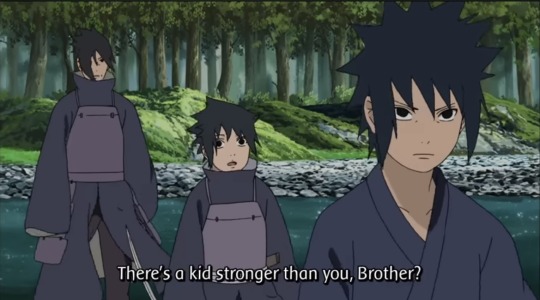

Or an absolute sweetheart
In the databook the following information is listed:
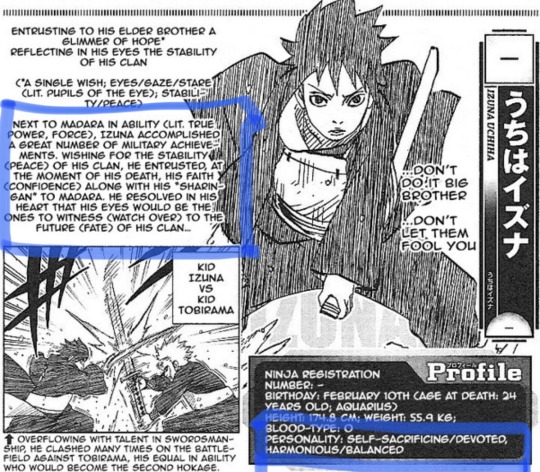
Izuna was Madara’s equal in abilities/power. He also accomplished a “great number of military achievements” according to the above. What those accomplishments are, exactly, remains unknown. That he was important to the Uchiha clan - probably both for his power and for his personality - could be one reason why Uchiha members defected to the Senju.
Both as shown in the Manga (as a child) and also above, he held Madara in high regard. He also trusted his older brother immensely. He offered, after all, their clan’s greatest treasure to his brother; and with it his faith (and confidence) that Madara could keep the Uchiha clan safe.
What we have to work with:
Harmonious/balanced
Self-sacrificing/devoted
In the anime - as a child - he appears to soften his voice around (especially) Madara (and even Tajima) as his voice was much more…cold when addressing Tobirama (for obvious reasons, but nevertheless) it is quite the contrast to Tobirama who appears to keep his tone of voice in check around their father (and in general really), while Izuna freely lets excitement be seen and heard even. There is an innocence there that probably got lost somewhere along the way of growing up.
So he is not as emotionally repressive as Tobirama. Which could indicate that there is a closer bond between the Uchiha family than the Senju family, or at least, a greater emotional honesty. The Senju siblings had to repress their feelings (at least, that was Butsuma’s wish…a wish Tobirama followed to the extreme), while the Uchiha siblings appear as if they are given more freedom to express themselves (Izuna’s disbelief and his excitement at seeing Madara’s Sharingan). Madara remains stoic and focused during the entire encounter at the river, for obvious reasons. He did not take kindly to nearly losing his brother in front of his eyes.
Now, the “harmonious” part of Izuna’s personality, is tricky to pin down. We saw too little about him for the “show don’t tell” rule to really apply to him.
At least if we think about “harmonious” in a particular - to even stereotypical - way.
“The definition of harmonious is things that go well together, or people and things that get along well. When you get along with someone and rarely fight, that is an example of a situation where you have a harmonious relationship.” (Yourdictionary.com)
If we use the above definition the harmonious part of Izuna’s personality could simply mean that he - in general - knew how to handle people, had a soothing aura, but that the one he got along best with, was his older brother - Madara. Who knows, perhaps they rarely fought? Being so in-tune with one another?
But we still do not know how he was around his clan, around Madara, when he was older, to say for certain that they were “one heart and one mind” type of duo.
According to dictionary.com the definition of harmonious is the following:
Adjective
1 marked by agreement in feeling, attitude, or action: a harmonious group
2 forming a pleasingly consistent whole: congruous: harmonious colors
3 pleasant to the ear; tuneful; melodious
This does not really mention how a human is when described as “harmonious”, besides the first one. Which pretty much states that you are in agreement in body, spirit and emotion/feeling…which does apply to Izuna. He is shown to be consistent in his behaviour and is not wishy washy. His opinion on the Senju does not change the little we see about him. Perhaps he was blinded by hatred, but so were the rest of the characters - even if said hatred was shown in different (and in more, or less, subtle ways).
Synonyms to harmonious (thesauruses.com)
Amicable
Balanced
Congenial
Coordinated
Cordial
Peaceful
Accordant
Adapted
We are getting somewhere, but I am still not satisfied with the answers I have found. I therefore looked into “peaceful” (as such was another word that was used to describe Izuna back in the day) to see if there was a better answer to be found with that word.
Adjective, peaceful (thefreedictionary)
1. Undisturbed by strife, turmoil, or disagreement; tranquil
2. Inclined or disposed to peace; peaceable
3. Not involving violence or employing force
Hmm…the first two could be possible descriptions, the third one…well…
The words calm and composed seem to describe Izuna rather well honestly. Even as a child, as well as an adult.
It could also just be that the “harmonic” part of Izuna was meant as him being a pleasant person to be around all in all. I can see him as someone kind, someone who went above and beyond to help and keep his clan safe.
Then again, despite going this far to make sense of this particular part of Izuna’s personality - there could be a more simple reason for some things not making complete sense, and that is that Kishimoto had not planned so far ahead when he wrote down Izuna’s personality traits. Perhaps he had a different plan in mind for the Manga? Perhaps he never expected having to write out the founding of Konoha - or perhaps he had a different idea in mind before he introduced the “Indra and Ashura” dynamic, and as such he had to backtrack and make Hashirama and Madara similar to Ashura, Indra, Naruto and Sasuke?
Who knows.

The official german translation goes as follows:
“Du ähnelst…Madara’s…kleinem Bruder, Uchiha Izuna.”
The official english translation is the following:
“…You’re a lot like…Madara’s…little brother, Uchiha Izuna.”
In my “Uchiha Izuna” comparison post I mentioned that the anime - while still vague - seems to imply that Sasuke and Izuna were alike in both appearance and personality (at least they could have been).
The german translation is vague. You can interpret however you wish here. Same with the english translation and the anime - honestly - and yet the anime…is a touch more concrete in a way. Considering the context. I’m rambling now, but I feel that the anime implies a strong (to stronger) likeness to Sasuke and Izuna being alike in personality. Hashirama does not know Izuna exactly, but that smile of his almost makes it seem as if he remembered something. Perhaps Izuna being similiar to the way Sasuke was in that scene? Considering that is what he says indirectly, it could therefore mean that Izuna was blunt and very “to the point” (with the Senju, it could have been different with other clans).
It is interesting to speculate what could have been.

Here Izuna showcases quite the arrogance (which comes back to haunt him just a split second later). It appears he was - rightfully - proud of his eyes and their power.
And while it does not really state who was the stronger of the two, a particular sentence from Madara (during chapter 661) stuck out to me while going through the chapter.
“It’s your M.O to strike an opponent just when he’s convinced of victory.”
And while this can mean any which battle, it could mean that Madara was remembering Tobirama striking down Izuna in particular. This could imply that Izuna had the upper hand, and could have made it out alive, had Tobirama not caught him off guard with his “hiraishingiri” technique.
But who knows, in the Manga we only got the very end of the fight. Izuna could very well have had the upper hand for a while, until Tobirama caught him off guard.
It says a lot that Tobirama had to invent a completely new jutsu to counter Izuna and his Sharingan/Mangekyō Sharingan.
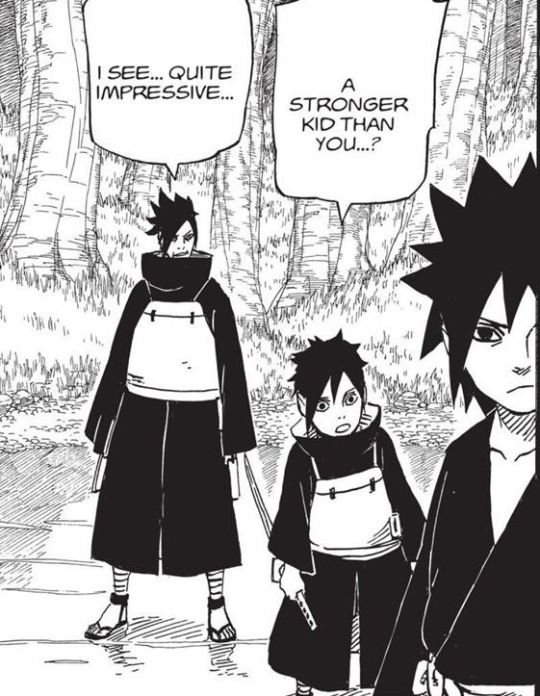
Aww, he is definitely young here. He is leaned slightly sideways, as if he is looking past Madara to look at Hashirama (most likely), while in the anime his gaze seems to be directed at Madara’s back.
I can imagine that Izuna was empathic - but his empathy was only really extended to his clan. Perhaps to an allied clan or two (if such arrangements were made), but that is not to say that he was not someone kind. I can imagine that he was…and that he would have been kinder to more clans than only the Uchiha, had circumstances been different.
They lived in times of war, after all. Kindness and empathy has no place in war. At least not to their enemies.

One can accuse Izuna for being selfish - the moment he willingly accepts his death before joining hands with the Senju. But that does not take away from his peaceloving and harmonic nature. Humans are complex, never static or “one way or the other” - one can interpret the Naruto characters in a similar way if one so wishes. Izuna probably wanted peace as much as any other Uchiha, but he saw an alliance (between Uchiha and Senju) doomed to fail.
It can be seen as Izuna being against peace, but I do not see him as someone averse to peace as a whole - he was simply wary of the Senju clan, and of Hashirama in particular.
And that is another thing that does not take away from someone being peaceful. I cannot claim that we humans get along with everyone we meet, and that would be the same for the characters in the Narutoverse were they real.
Izuna simply looked out for his brother and the clan - the way a second-in-command should.
Even if Madara had accepted the ceasefire then and there, would it truly have lead to the peace Hashirama envisioned? Madara was not particularly clear-headed and could - theoretically - have agreed to any condition, Hashirama could have made, in his distress. Which would have invoked Izuna’s ire most likely.
It would not have been an agreement on equal footing and terms. It wasn’t even when Madara finally accepted Hashirama’s agreement.
Madara wanted to believe in Hashirama and their “pipe dream” (as much as he tried to deny it) - but Izuna did not have the same faith in the Senju clan.
Suspicion and fear also reared its ugly head, and can one blame him for such? Not really.
Being wounded by your archrival, being in pain and dying, and the leader of their nemesis dares to offer an alliance in that moment? Suspicious and hypocritical.
Everyone would be at fault - in one way or another - had the situation been real. Both Senju and Uchiha are as much victims as they are perpetrators of this vicious cycle of hatred.
While this is speculation, Izuna was probably quite the strong willed person. We do not know how the wound killed him, but it - most likely - got infected and caused him a slow, agonizing death.
He probably laid dying between days to perhaps a month at most.
Looking at the background during the skirmish it appears to be summer, and when Izuna passes away it is autumn. He probably had to cling to life for at least a few weeks…I can only imagine how painful such a situation must have been to both brothers. Imagine the agony of watching your most precious person waste away, watching him slowly die, while you can do nothing to save him.
It must have chafed at Izuna’s pride as a warrior as well, dying in such a “undignified” way. Honour has always been important to the Japanese, and I wonder how many can truly empathize with their way of thinking (“bushidō”) - and that you should kill yourself before bringing “shame” to your family name/yourself.
That’s…terrifying and tragic. And yet it is also quite sound…considering how valuable a hostage could be (or a corpse or two…).
It is while Izuna laid dying (we are only shown Madara’s anger after his passing - anime only scene at that) that he offered Madara his eyes. This, at the very least, implies his devoted nature. Like Obito, he gave up their clan’s treasure (Sharingan) so that his beloved older brother could look after one thing he, Izuna, held dear.
No matter who he might have been, we know one thing for certain, and that is that Izuna was devoted to the clan, to Madara, to the very end.
#izuna uchiha#izuna#naruto analysis#thoughts#I can see Izuna as a more balanced Sasuke in a way#more arrogant as well#perhaps even a touch more cold/unhinged at times#being a child soldier and all#sasuke and izuna being similar is not a strange thought to entertain#if nothing else they might have reacted to trauma in a similar way#long post
200 notes
·
View notes
Text
Bleach character’s and their planet placements
Yes, it’s what you're thinking - this is a post about what planet placements different characters might have, here we go (The sun signs are from offical databook):
Ichigo - Cancer Sun with
Moon in Scorpio: Mom related angst? Ichigo is a poster child of Moon in Scorpio placement, these people often come with a big emotional baggage when it comes to their moms and let’s not start with the complicated inner world he had
Mercury in Leo - Honestly, the reason I gave this placement to him is that Ichigo loves Shakespear, these people are fan of poetry and are more inclined to do well in humanitarian subjects. As it is revealed Ichigo became a translator, so I think the Leo Mercury makes perfect sense for him.
Venus in Cancer - he is a family man, need to say more?
Mars in Aries - Ichigo is very hotheaded, goes straight into action without thinking much and it’s always insticts driving him, rather then logic, also he has big and endless energy, just like Mars in Aries.
Rukia - Capricorn with
Moon in Aries: Rukia is a true definition of independent woman who knows how to give others motivation. She steadily rises to any challenges and is an honorable warrior. Besides she is very explosive and never shies away from anger - a true Moon in Aries Queen
Mercury in Aquarius - she is a very progressive and individualistic thinker and her weird chappy drawings are definitely the product of this placement.
Venus in Sagittarius - Rukia is in no way a romantic, but when she loves, she loves deeply and always places huge ideals on people she deems close.
Mars in Virgo - She is very practical, hard working and a bit self-sacrificial. Think this placement makes sense for her.
Orihime - Virgo with
Moon in Cancer - a perfect bundle of empathetic, caring and emotional. She even has that round face that many Cancer Moon gives.
Mercury in Libra - Orihime was the hopeless daydreamer and romantic. Never brisk or rude when it came to communication.
Venus in Libra - Again, we come to romance and love. She professed her undying love and wished that she had 5 lives but one love interest in all of them. Yeah this Venus natives are that romantic and pretty much in love with the idea of being in love.
Mars in Virgo - Orihime was always good with house chores and she is a healer, she might not be the best of warriors but never backs down from doing work.
Aizen - Gemini with
Moon in Leo - this man had a HUGE ego. Not to mention, Aizen did all the work just because he didn’t want to be under anyone else’s rule, this moon has the narcissist jumping out and the hair game is on point always, when it comes to Leo.
Mercury in Gemini - This placements are clever as hell, big multitaskers and sharp minds.
Venus in Taurus - Aizen was a man of Luxury, what can I say.
Mars in Scorpio - Scheming for years and making sure everything is under your control? Leave it to this placement to execute everything perfectly and without anyone knowing.
Byakuya - Aquarius with
Moon in Leo - one thing Byakuya is is a prideful man with a hint of ego lurking on the surface. Besides he was quite a hothead and is a secret one still to this day. No one better to do that with than good ol’ fire moon. Not to forget, he has a fabulous hair.
Mercury in Capricorn - A true conservative. He knows how to carry on the legacy and is a very reserved talker, unless provoked.
Venus in Aquarius - this placement is a rule-breaker and nonconventional when it comes to love affairs. We all know who he married and how he defied rules to have Hisana as his wife.
Mars in Capricorn - cold, disciplined and unapproachable, that’s our Byakuya so I went with this Mars placement.
Yoruichi - Capricorn with
Moon in Gemini - this placement is chill, playful and doesn’t tend to dwell on things much like Yoruichi. It’s all fun, flirting and games for this Moon
Mercury in Sagittarius - she is a free spirit, doesn’t care much about formalities and often says things as it is
Venus in Capricorn - I’m really not sure about this Venus placement for Yoruichi, but taking all the signs, this might be the perfect choice for her, considering her noble lineage. (Another option: Scorpio Venus, goes with her character as well)
Mars in Sagittarius - Legs and tighs! yup, no one has it better than this Mars sign just like Yoruichi.
Ulqiorra - Sagittarius with
Moon in Capricorn - to say it lightly, this Moon doesn’t do emotions well and one thing Ulquiorra struggled were his and other’s feelings, having problems with nihilism.
Mercury in Scorpio - he isn’t man of many words, but when he speaks he doesn’t play around goes straight to the point. Also he is very observing.
Venus in Scorpio - Ulquirra had the theme of Lust going on, what other Venus to give him than Scorpio, with his depth and obsessive nature.
Mars in Virgo - he was a dutiful and responsible man, always doing what he was given orders. This Mars knows how to do exactly that
#bleach#ichigo kurosaki#kuchiki rukia#orihime inoue#sousuke aizen#kuchiki byakuya#yoruichi shihouin#ulquiorra cifer#ichiruki#ichihime#byayoru#aizen#astrology#natal chart#mine#bleach: tybw
33 notes
·
View notes
Note
Can we trust databooks and chapter's covers? Did Kishimoto write them?
Like some databooks claim that Sasuke and Karin were in romance, Sakura used to have crush on Sasuke, Sakura filled Sasuke's lonely existence with love. On cover of chapter 363 it is mentioned that Sasuke left or threw away love and ss think it means he left/threw away his love for Sakura.
Haiyya.
No. Databooks, novels, games etc are not canon. NONE of them. Dot. Period. Kishi didn't write them. One of those few pages, where Kishi wrote Sasuke saying that the kiss tasted like miso, that apparently was written by Kishi and that was the reason it was written in first person. But honestly, you can go ahead and disregard that as well if you want. It seriously doesn't matter.
What matters is the story and the story only. Kishi personally wrote parts one and two, Boruto movie, Gaiden and those few extra chapters, one as a pretext for Road to ninja movie and the one where Naruto misses his hokage ceremony. And the one as a pretext to The Last where Kiba and his dog are the MCs. And a couple of pages where Naruto takes Hinata on a date.
Databooks are compiled by the editors. Why else would it talk about things that blatantly go against the story and the actual characterisation? Only people in the fandom, who want to go five steps deeper, have the time and patience to read the databooks. They are just extra material provided by SJ for fans as fanservice. It boosts publicity and keeps the fans interested. That's how any media business works. Just like novels and games which are merchandise. They are NOT canon and they are not to be taken seriously. When you read Harry Potter, what's canon for you? The actual books or the games based on them or the fanfiction based on them? You think the creator has the time to put that kind of effort and time that he already has a shortage of in derivatives of the original work? Kishi sometimes draws the covers of the novels or poster art etc, because he is under the contract by SJ. The novels have his name and the name of the actual writer of the novels written on the cover. Kishi's because he is the original creator of the characters. He has no participation in the actual stories.
He supervises Boruto, and he also was the creative story supervisor of The Last, where he said in an interview that he didn't write the romance bits of it, because he felt embarrassed to make two of his characters, that he thought of as his own children, kiss. Lol. He sure didn't feel embarrassed when he drew a naked Sai and Sasuke performing full on sexual foreplay in fucking canon. Also, Hinata's and Sakura's characters in it are pretty much in character.
But people who understand Kishi's writing know why he does the things that he does and says the things that he says. ALL of it pans out logically. A lot of it because he wrote a gay love story in a limiting genre such as shounen, which itself was a brave and risky thing to do, so he has to be careful about what he says in the interviews. And a lot of times, he just runs his mouth, and why won't he? He wrote such a great story diligently for fifteen fucking years and he can't even talk about it freely because of the limitations of this genre. He wanted to write something different, something that hasn't been done in shounen before, so he wrote a gay love story, which reads like it comes from such a deep and personal and emotional place, but he had to sacrifice other things for it. For example, the ending.
He says other stuff too in his interviews, the snarky stuff, that he says about Sakura and Hinata, tongue in cheek, because he is petty and he enjoys it and he also looks down upon people who aren't able to see his true intentions. Because of their own projection. And I don't mind it honestly. His hands were tied. So if this is the way for him to take his frustrations out, so be it. It's partly the reason he wrote Gaiden. He could have written it so differently, it was a new angle, he wrote new elements in it, but he chose not to. He decimated SS in it. Because he wanted to. Because he couldn't care less for SS. And he has never shown anything but disdain for Sakura's character consistently.
You know how he would feel for the SS stans? The same thing he felt and said for Sakura's seiyuu who was just so excited for Sarada's character, the result and reason for SS. Heh.
Mockery. It's pretty consistent too.
You can go ahead and stamp it up on your mind, only the original manga is canon. Plus few other things mentioned above. What Kishi wrote. Nothing else matters. Absolutely nothing.
As for chapter 363, this.
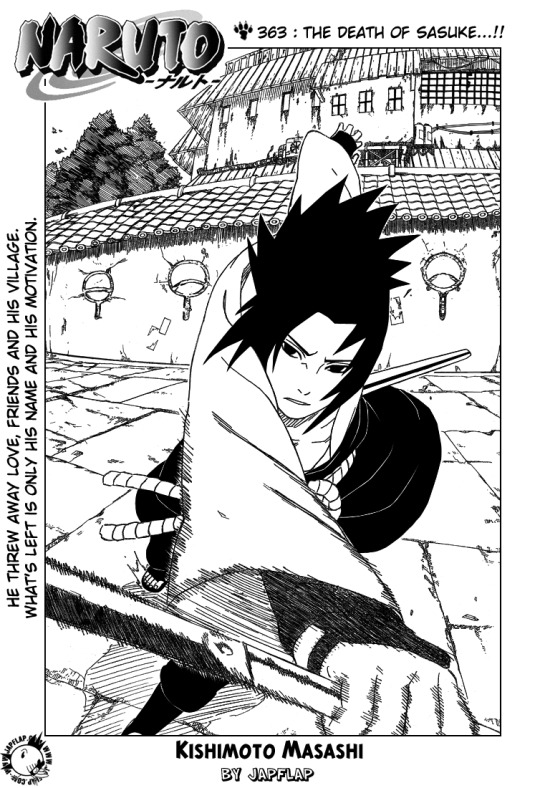
Guys. Do you really think Sasuke said this for Sakura? What does your understanding indicate?
With all due respect, I need to say this. You guys are just way too gullible. SS are one of the craziest and most delusional fandoms in the history of fandoms, so much so that, its own creator mocks it relentlessly.
Do you really think Sasuke means Sakura when Kishi talks about his love?? For real?
Who is Sasuke's one and only.....friend? Who is the ONLY one Sasuke needs to 'cut off' to be truly alone? Who became Sasuke's 'closest friend' which Sasuke himself said was very significant for him? Who is his 'Usuratonkachi' which is his word in Kishi's most favourite panel, a conclusive, final panel that he had already thought of years before the manga ended? Who is the person Sasuke protects and cares for at the cost of his own goals and ambitions, no matter how small the threat, and even almost died for without a second thought? Whom does his body move for on its own? Who is the person he shed happy tears for? Who is the person he resonated with, who related his loneliness with, and who felt warm and fuzzy for, who reminded him of his bonds with his family, his core motivation?
Now who is the person he apathetically attempted several times to get rid of in part two? Who is the person he called annoying and was utterly unimpressed with, who got called annoying by him consistently? Who was the person he said he had no reason to love and that person has no reason to love him? Who was the person he couldn't care less for and left to die in lava dimension but rescued Naruto even when he didn't need to be rescued? Who is the person he cannot even respect as a fighter, who is the person he can't even bother to answer the queries of? Who is the person he can't even bother to thank or apologize to properly? Who is the person he clearly said in reunion that he had already cut off his bonds with? Who is the person he doesn't see for 12 years? Who is the person he is never happy to see, who doesn't even smile for?
Also, what do you understand by love? What does love mean? What do you feel when you love someone?
Someone with whom you resonate deeply with, with whom you share your loneliness, whom you would give your life for and whom you would protect tooth and nail at the expense of your own life in order to sustain their goals and dreams, to have them live at the expense of your own ambition, someone whom you smile and laugh with, someone who makes you feel like family, warm and cared for?
OR
Someone who you show at best some friendliness but then at their lack of understanding and empathy makes it easy for you to cut off your bonds with? Someone whom you can't respect? Someone whose intelligence and instincts you can't trust? Someone whom you can't even take seriously?
Do you really need me to answer these questions? For real?
Do you really cannot see something as crystal clear as this? Would you really let yourself be manipulated by silly ass SS who Kishi himself made the laughingstock of the fandom? Why do you give them so much credit? Honestly, if this was some experimental cinema that you needed explaining, I would have done it. I do explain the more indirect parts of it anyway. But you seriously gotta be smarter than that guys.
SS have NOTHING except for their crazy ass delusions. Trust your instincts. Trust Kishi's writing. He is the freaking creator. Who would you believe, him, the one who wrote this story or SS who come up with crazy ass garbage bin metas? Give yourself some credit.
I have like sixty repetitive asks just on the topic of SS said this, SS said that, and you guys ask this to every SNS analysis blog there is. And they all pretty much say the same thing. And why wouldn't they? Because that's what Kishi meant you to read. It's hardly rocket science. It's so goddamn clear for everyone to see. But you guys are still so goddamn insecure.
Even casual fans can see it's about SNS and both SS and NH are last minute shit for the sake of Boruto. How?
Common fucking sense.
SS have to be delusional to believe in their ship because they literally have NOTHING else. And they say shit like this and you believe it willy nilly.
Forget SS. Read the manga for yourself. Make your own conclusions. I don't mind explaining stuff but I draw a line at spoonfeeding shit that is already clear as crystal. What do you want me to do? Teach you the alphabet? English? Words? Sentences? You want me to be your kindergarten teacher?
Seriously. Stop. Doubting. Yourselves. Kishi's story might be a little indirect but it's not incomprehensive. Really, it's not difficult. For the most part, it's pretty straightforward. For the rest, I am here and I would do my best to help you understand. Which I already do.
But put some effort yourselves. And for heaven's sake, don't be so gullible. Don't be so fucking EASY.
YOU, SNS, have EVERYTHING THAT MATTERS. Fuck NH, SS. NrSk, SK. They have nothing. And you have one of the best written love stories in the entire world.
And you are still so damn insecure, it's seriously ridiculous. Kishi put so much damn work in this love story, you apparently are in the fandom because of it, but you still doubt it. At the end of the day, it pretty much negates what Kishi himself wrote with so much damn effort. All because of- SS SaiD tHiS, Ss saID thAt. 😭
This is a love story about Sasuke and Naruto.
I have said it a million times already. Trust your instincts. That's how stories work. That's how they are written. Follow the story for the story's sake. Not for shipping. You are not in competition with ANYONE. No one can compete with SNS, how can they? The whole story is a love story about THEM! Unless that's all you care about. Competing. In which case, go to someone else. I am here to talk story and characters. I don't give any credit to NH and SS and you are only enabling them when you obsess over every little stupid thing they say. Stop it.
125 notes
·
View notes
Text
Thoughts on Izuna vs. Tobirama
As far as we know, we can assume Tobirama created the Hiraishin Jutsu to fight the Uchiha and balance out their natural battle advantage their Sharingan gave them.
However, I have to wonder – why did he first use it on Izuna (of all people)? He could have chosen any other Uchiha, but no, we are shown he chose to use it to defeat Izuna specifically.
The reason why I believe that Izuna was the first victim of this Jutsu is simple – Kishi could have chosen any other Jutsu Tobirama created at that time, as all of them were most likely created to better fight the Uchiha clan, however he chose this specific Jutsu, and thus he probably did so for a reason; to show not only how Izuna died, but also the origins of this famous Jutsu. The other reason I believe Izuna was most likely the first victim is also simple – both clans were constantly trying to best each other (we see the proof of that when both clans come up with the exact same idea at the river confrontation when Hashirama and Madara were young) – and I am quite convinced that (realistically), had Izuna seen the Hiraishin Jutsu before, he would have been (probably) more prepared, and would have expected Tobirama to try to use it.
The clearest evidence of my theory that Izuna really was the first person Tobirama used this Jutsu on, is Izuna's face right after he was hit by it, as both the question marks in the middle panel and his face in the right down panel show clear surpeise (although it could be argued he was just suprised by being injured in general).
So, coming back to my question: Why did Tobirama use this Jutsu on Izuna specifically? Why, again of all the Uchiha, did he choose Izuna?
According to the databooks, they were equals in power, however that likely wasn't the only reason.
Now, this is just me theorizing and it is more a realm of headcanons, however I just have to wonder if perhaps Izuna's Shinobi skills (he was regarded as one of the best among the Uchiha after all, and he was also, like Madara, the first of the two to awaken Mangekyo Sharingan) terrified Tobirama in some way. I simply believe there had to be a reason why Izuna was feared the same way Madara was – and I just have to wonder if Tobirama was, just hypothetically, scared of his abilities the way we were shown he was scared of Madara's. Izuna's position in the clan – him being the clan head – might have also played the role, for defeating him meant weakening the Uchiha (and especially Madara).
I also have to wonder (and this is again more in the realm of headcanons) how the situation would differ had Izuna's eyesight been completely intact. We can (logically) assume he was most likely using his powers (probably even Susanoo), and therefore he must have been affected by blindness too (it is quite ridiculous to assume Madara was the only one of the two suffering from it). So had Izuna's eyes worked properly, would he still be defeated? (Probably would, due to plot, but would it be the same?)
There is just so much information to be pondering about, and I am still sad we didn't get Madara's flashback where at least some questions could be answered.
60 notes
·
View notes